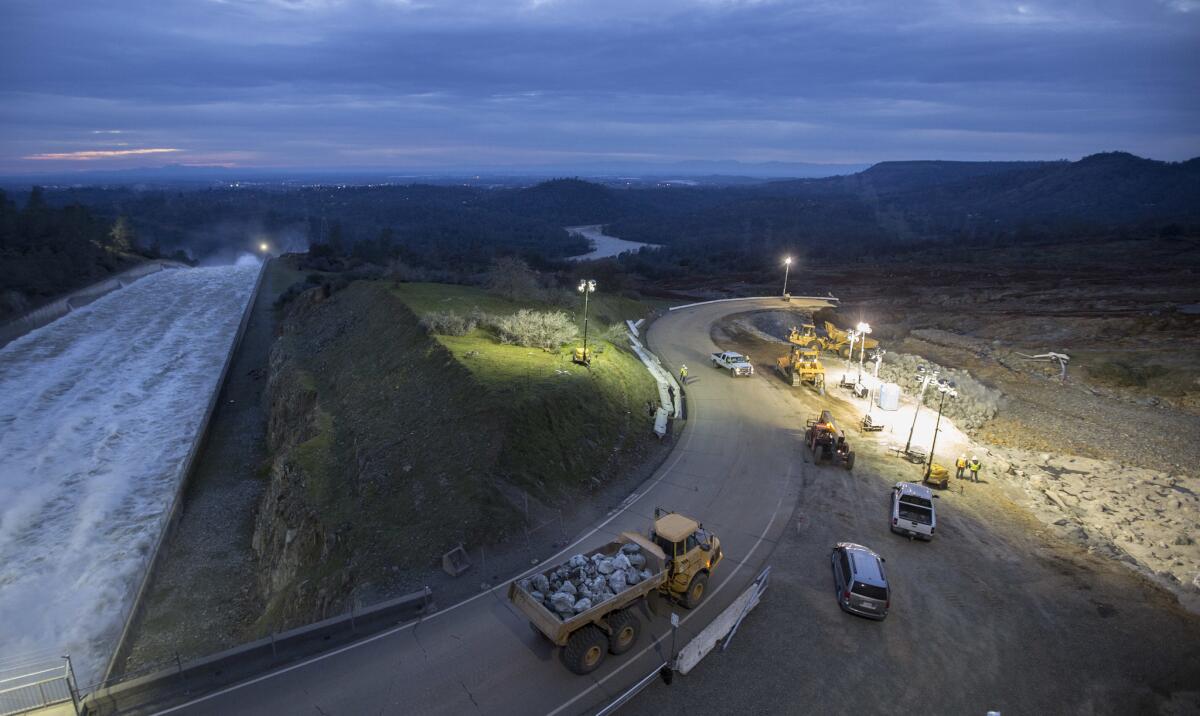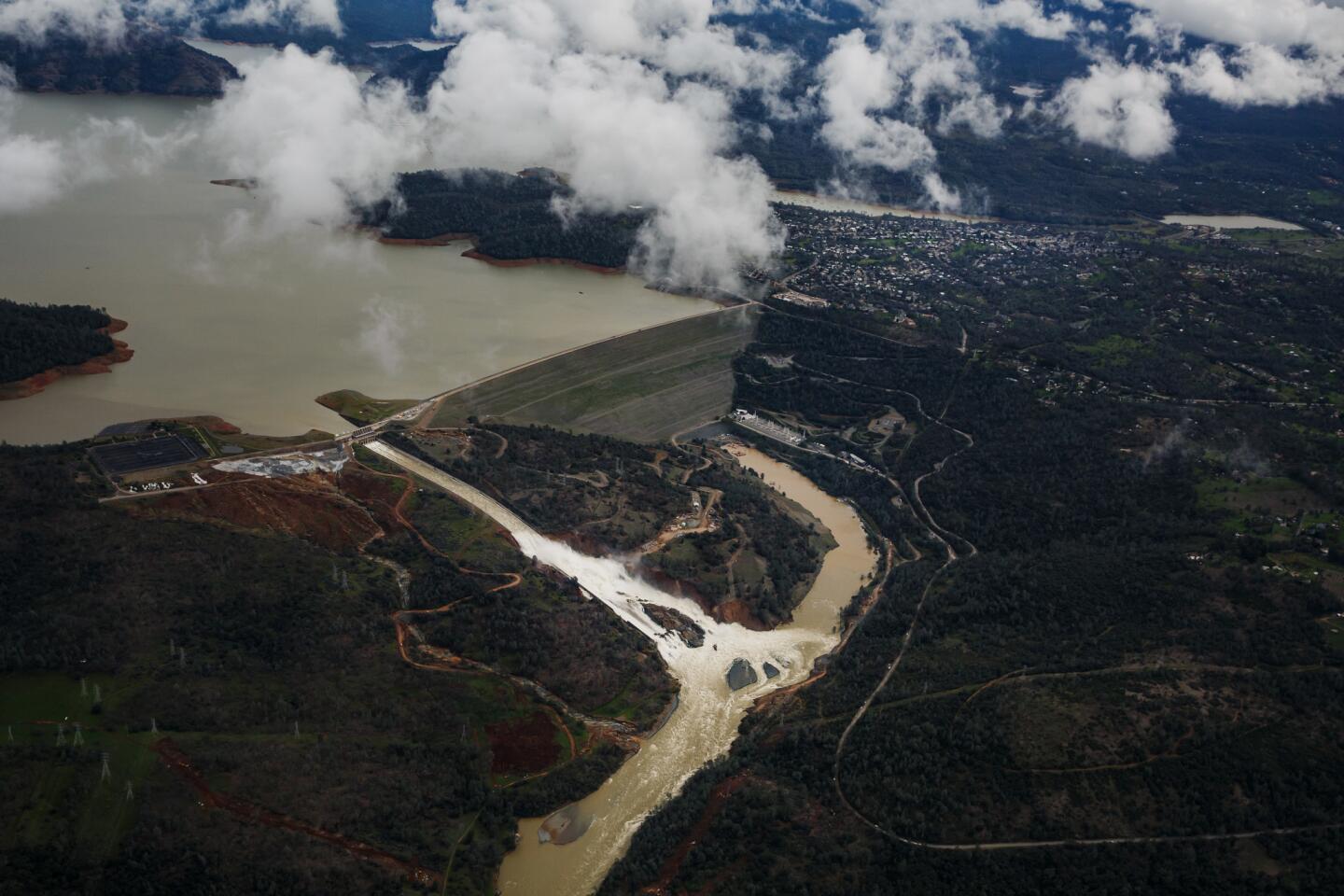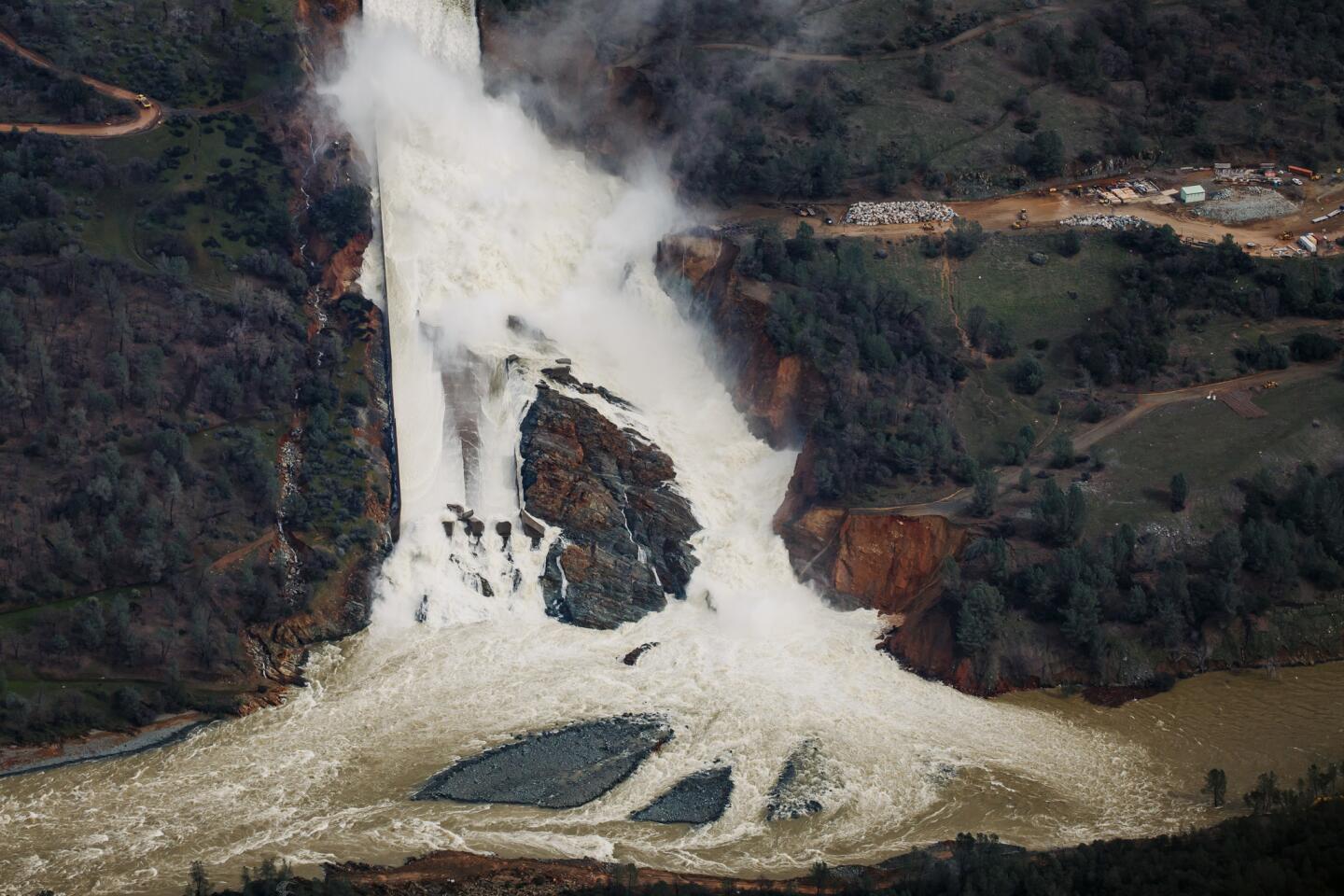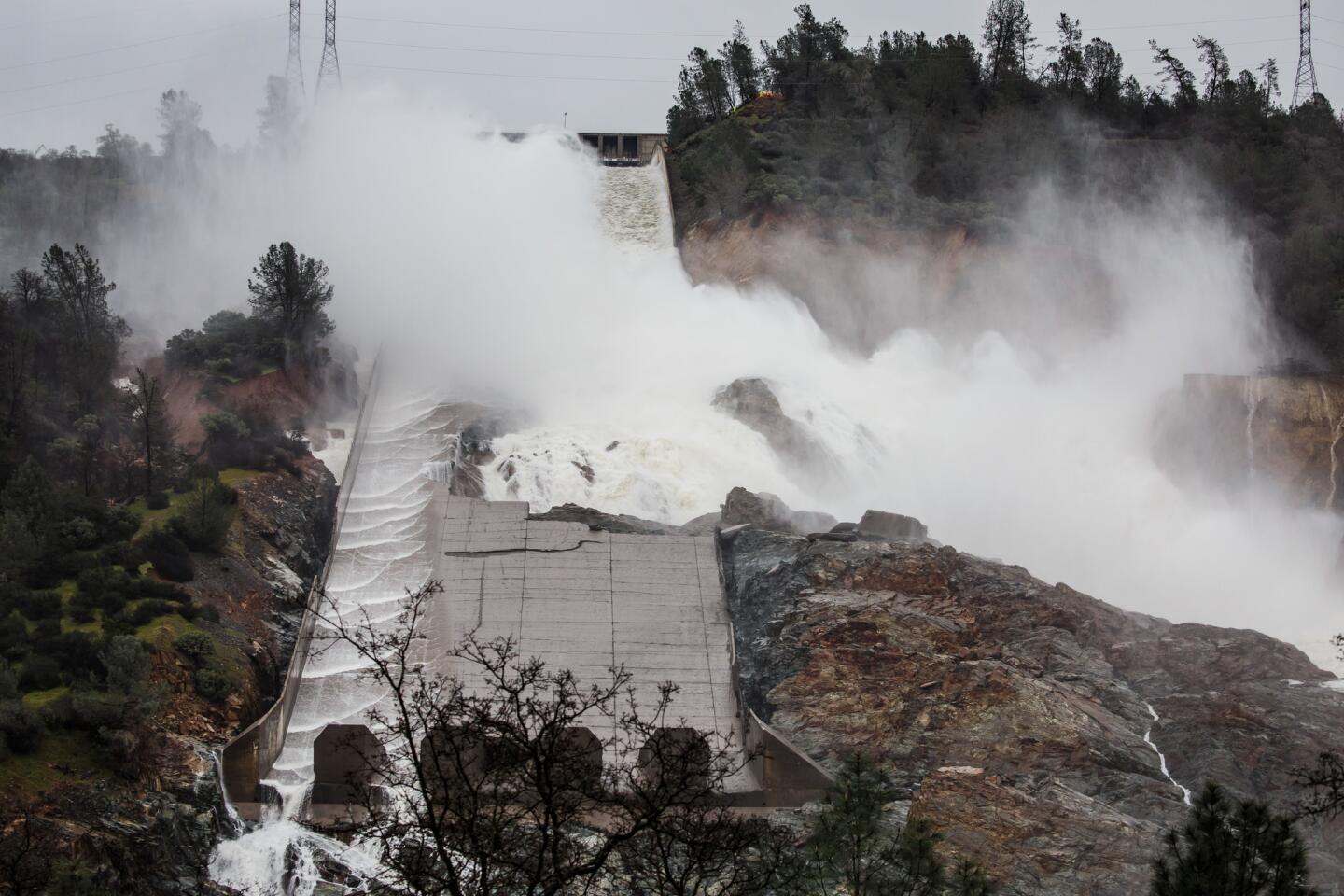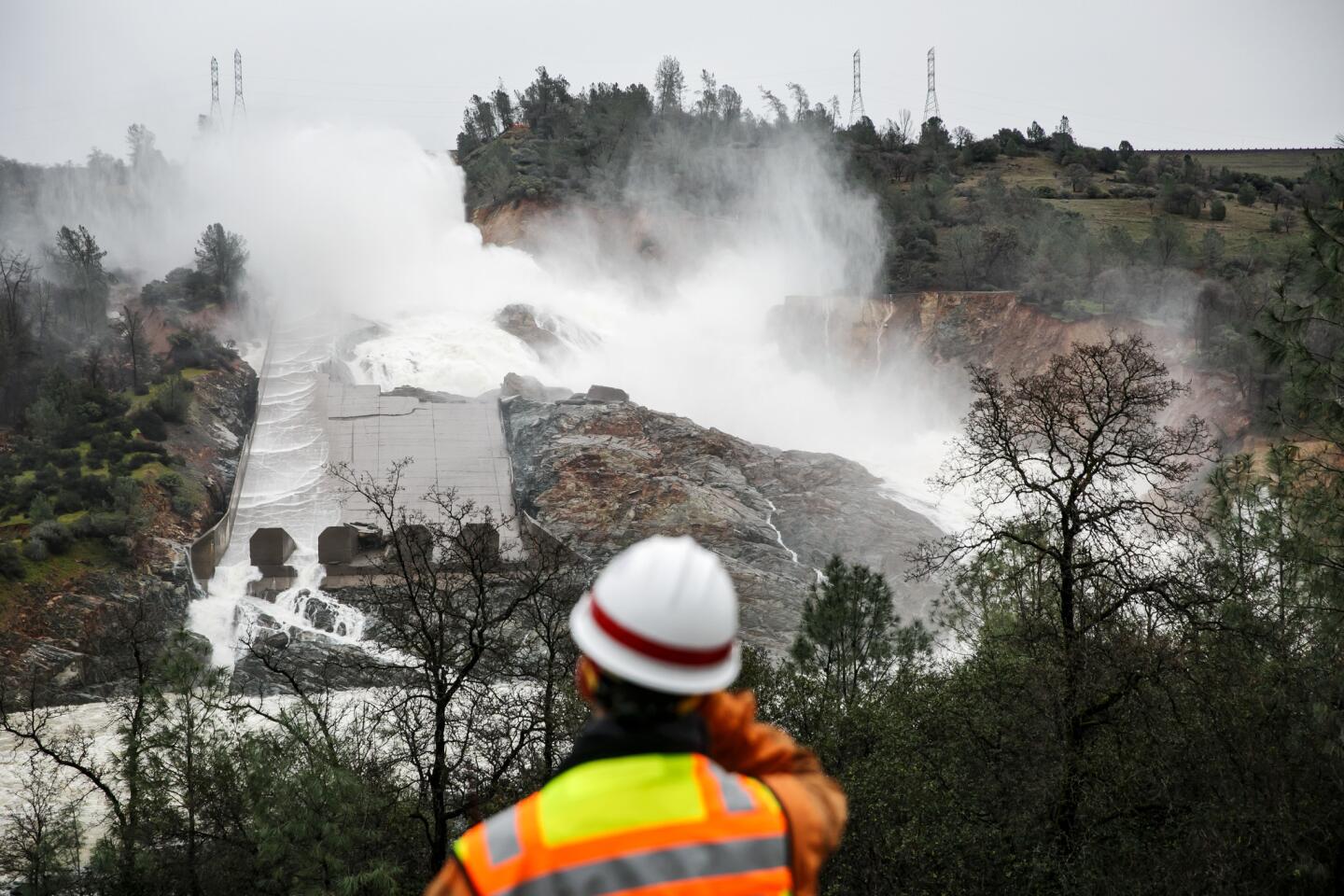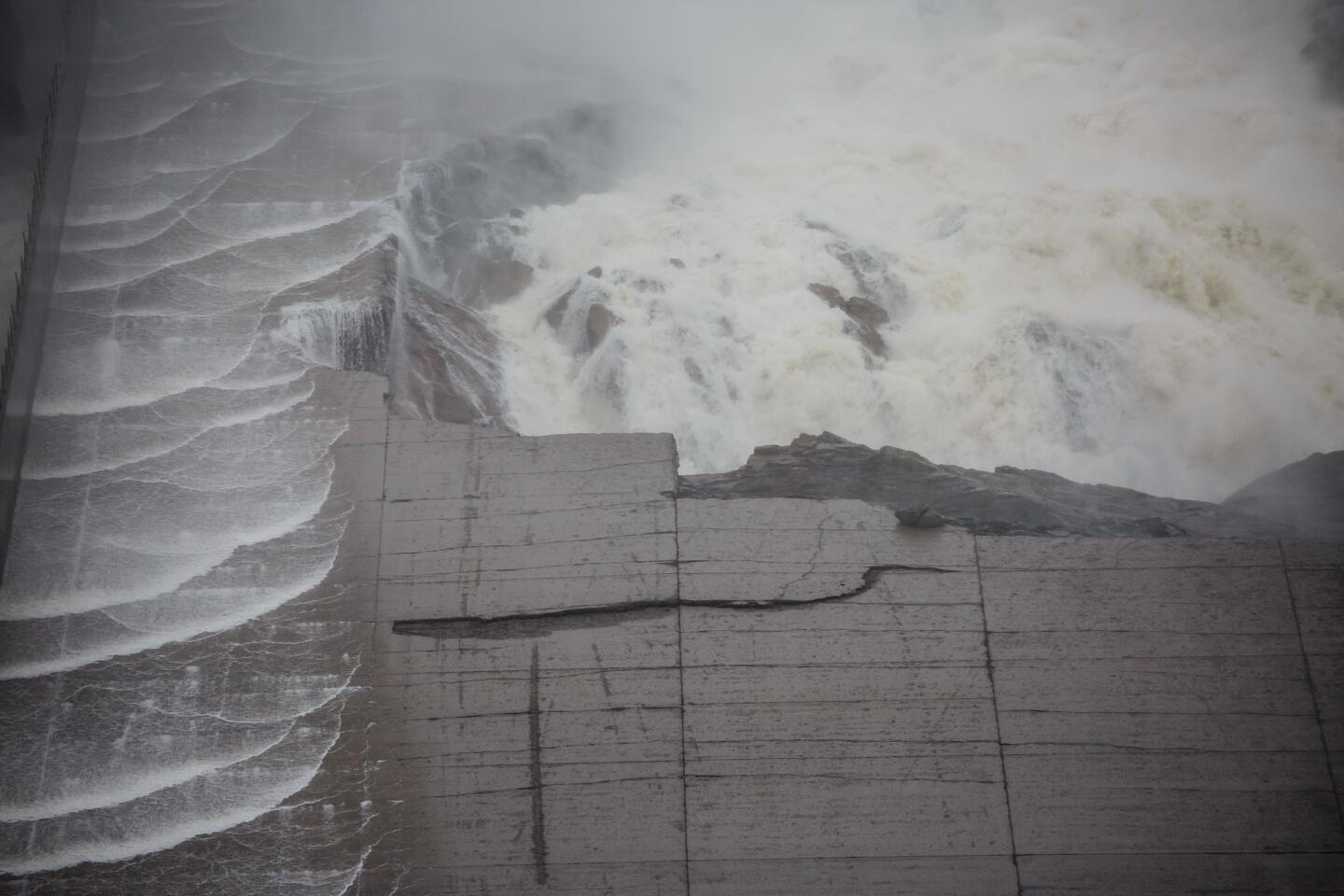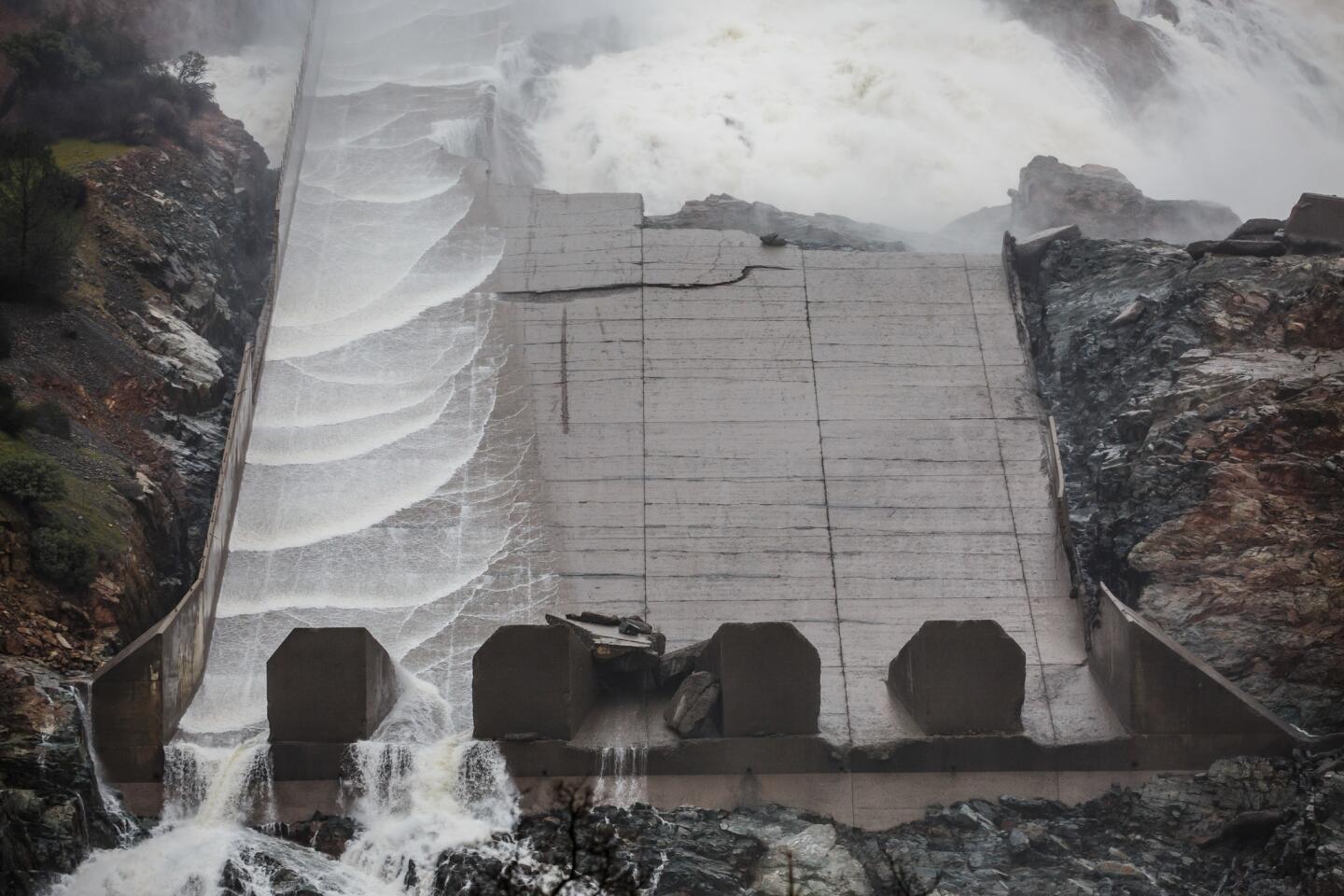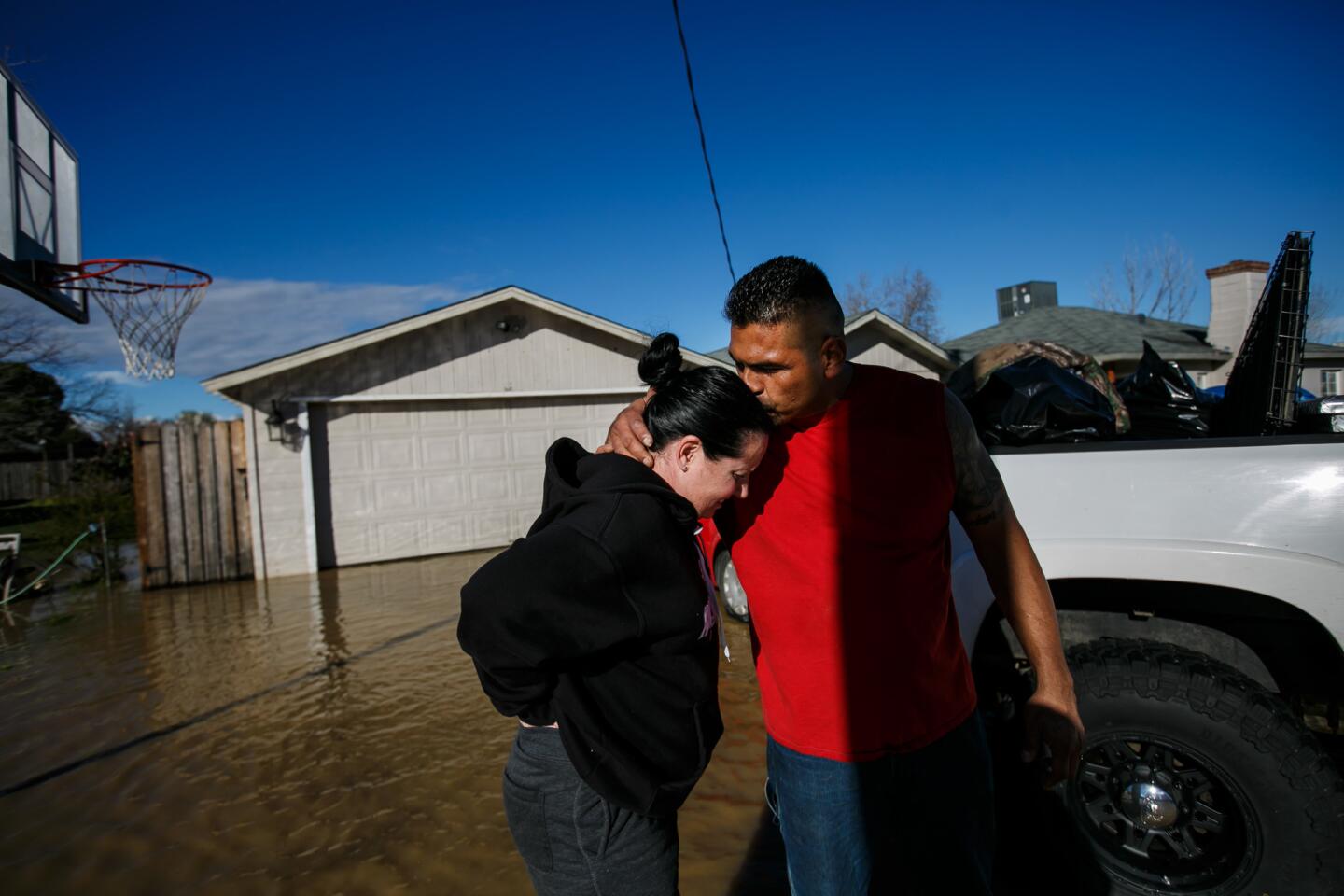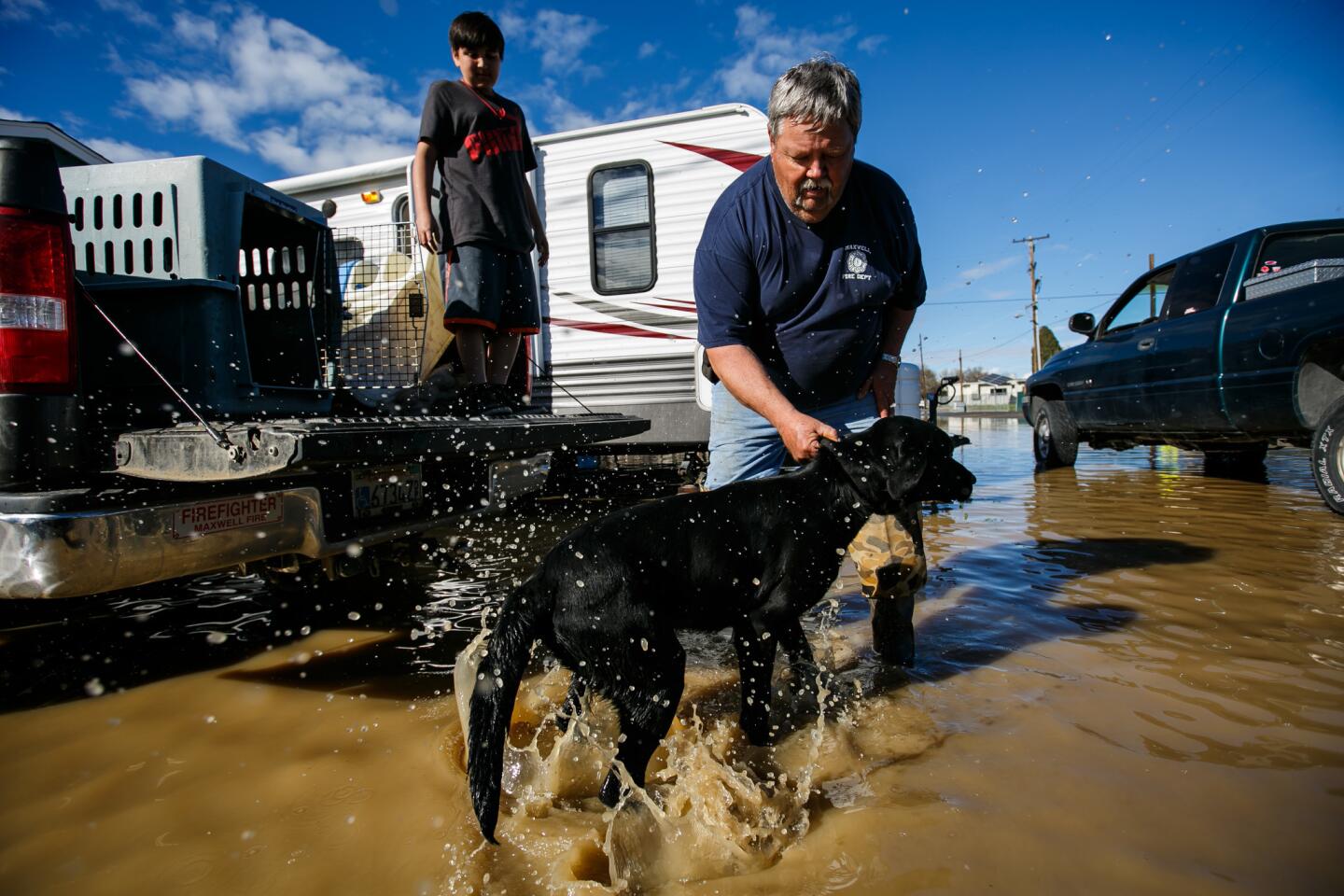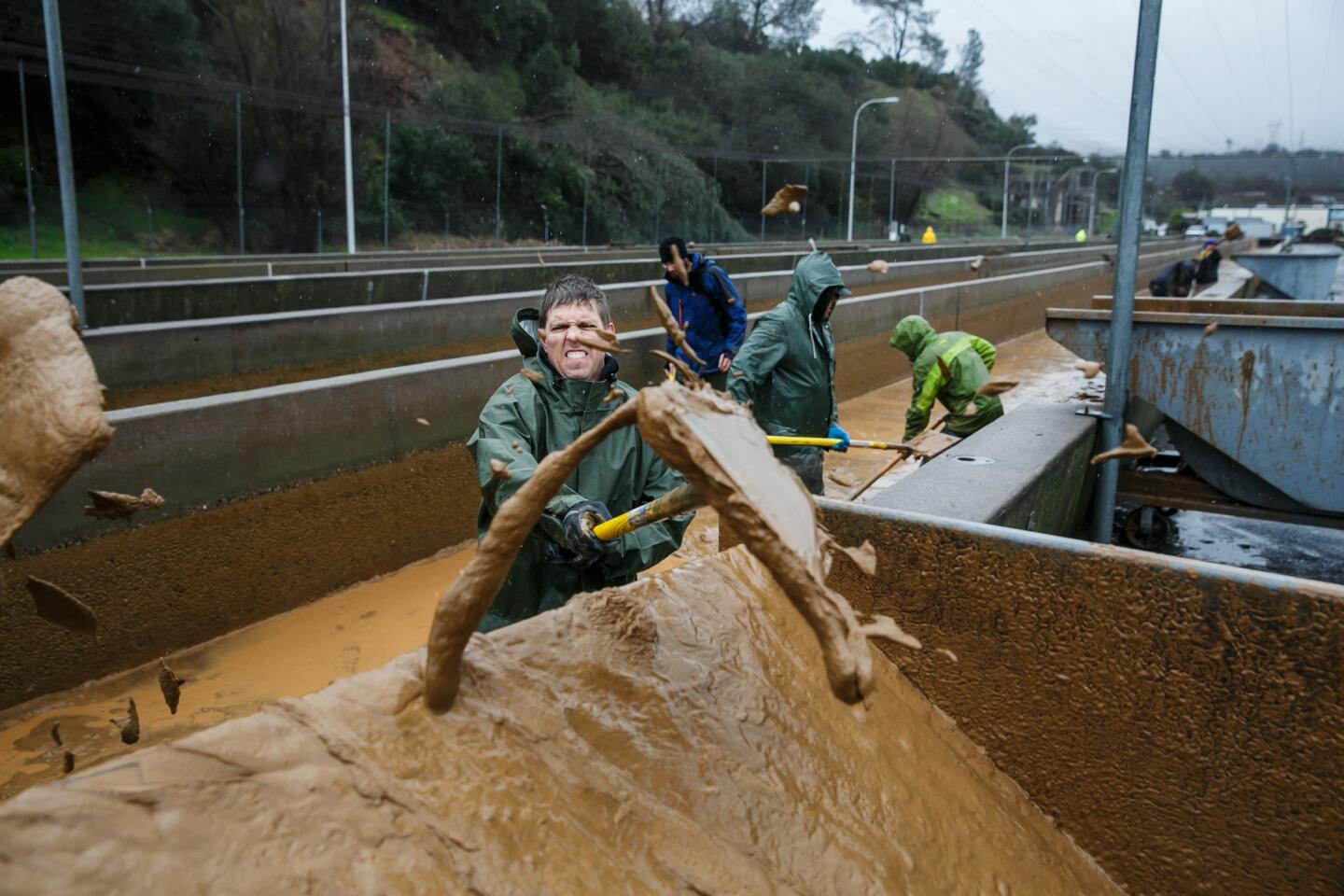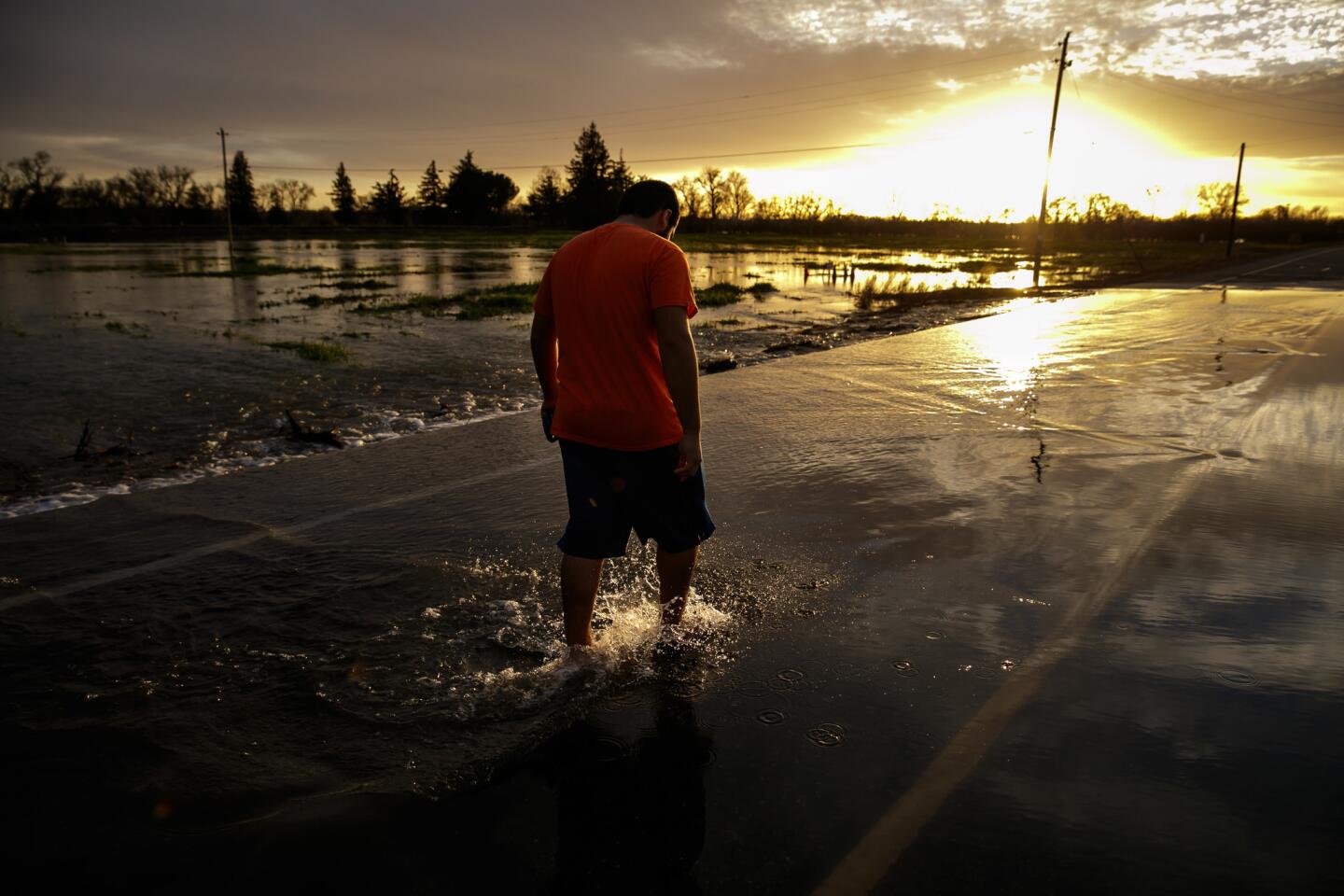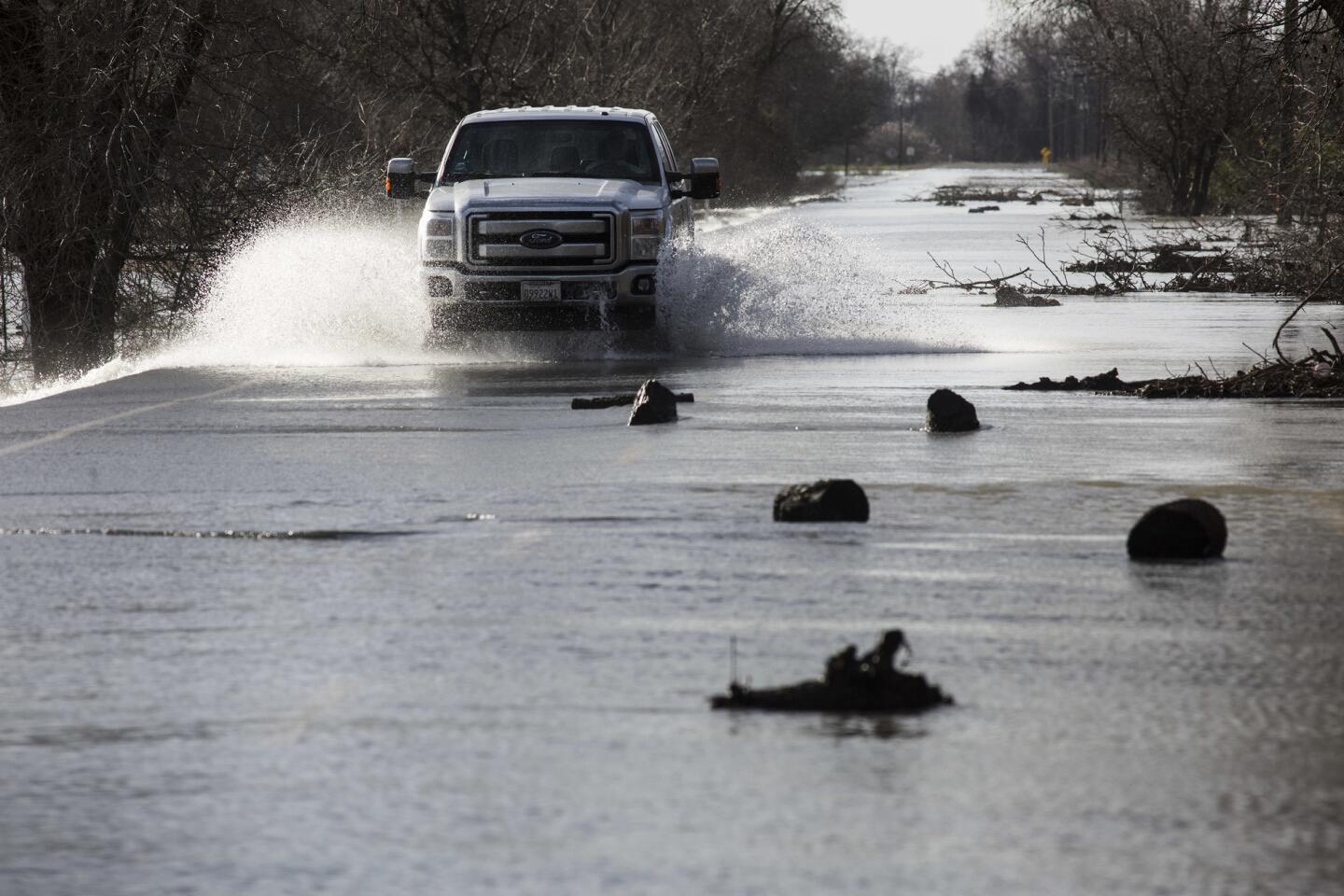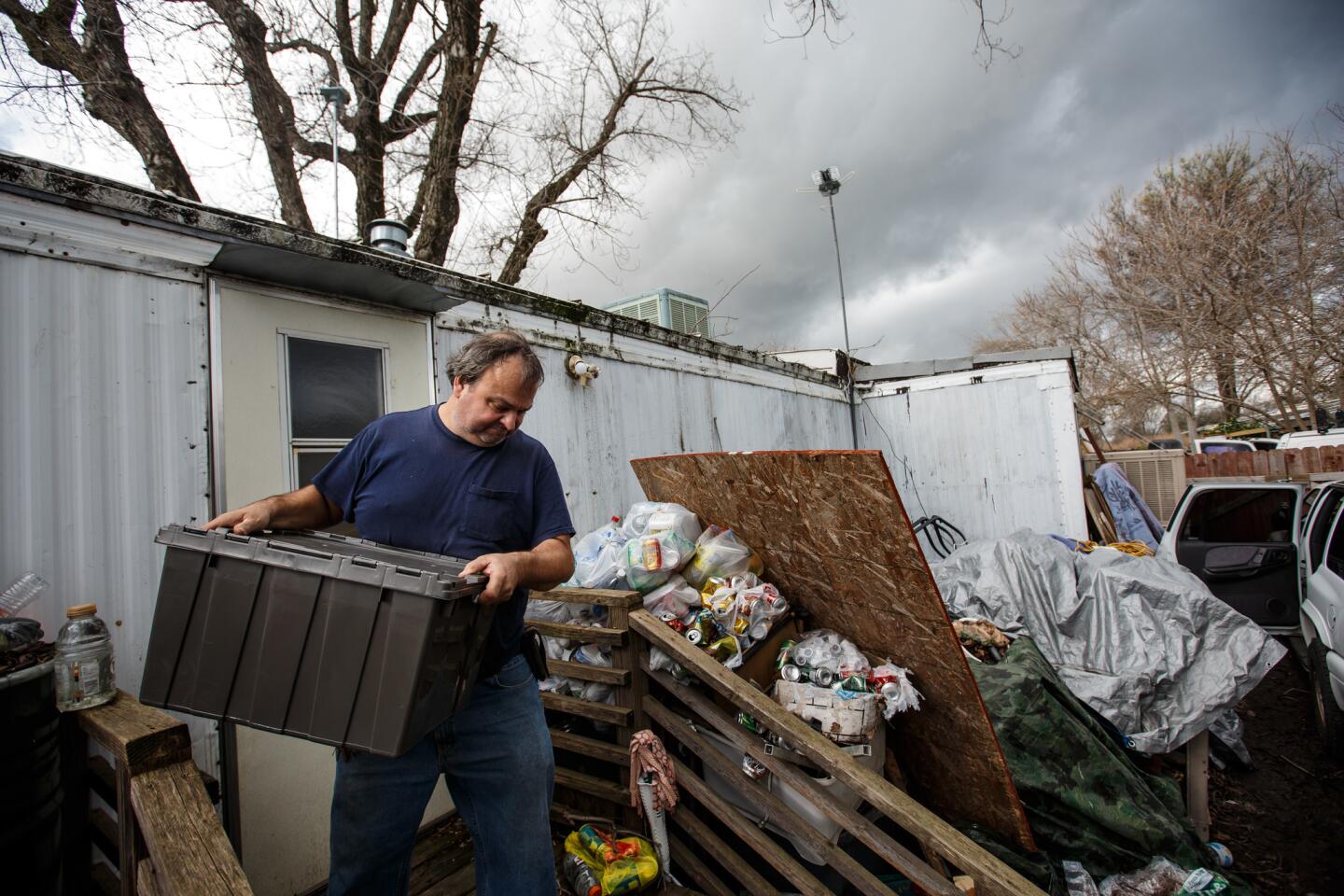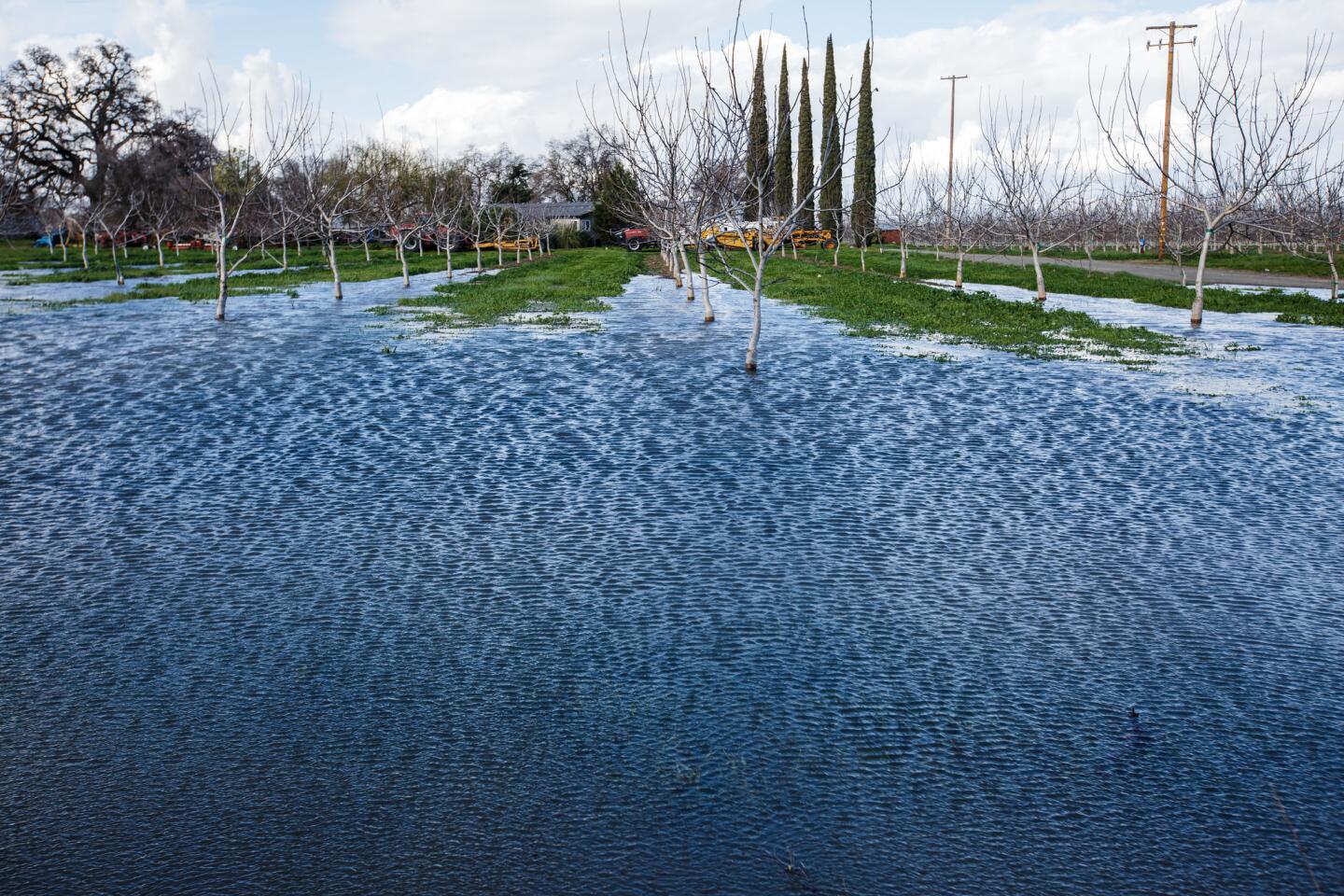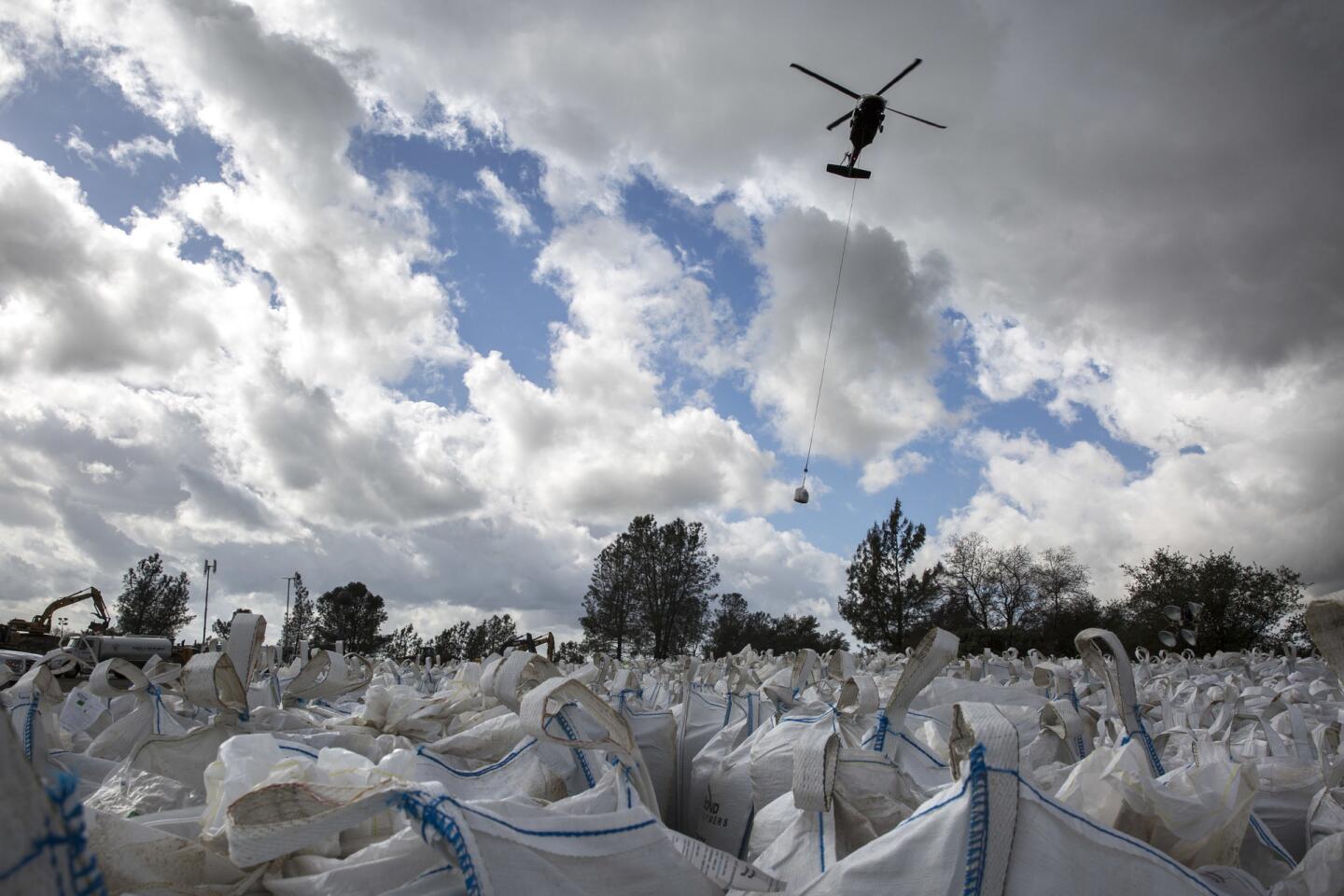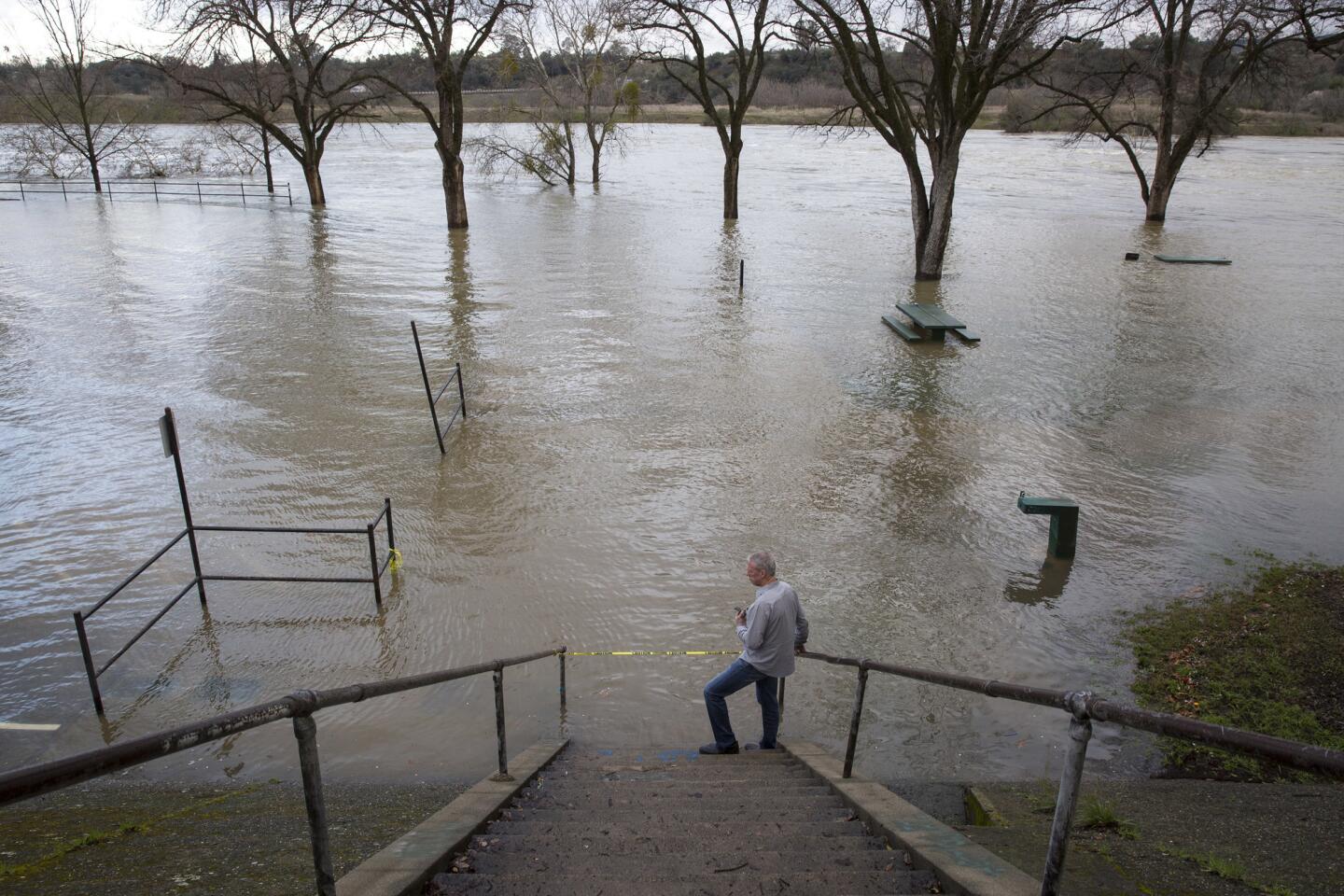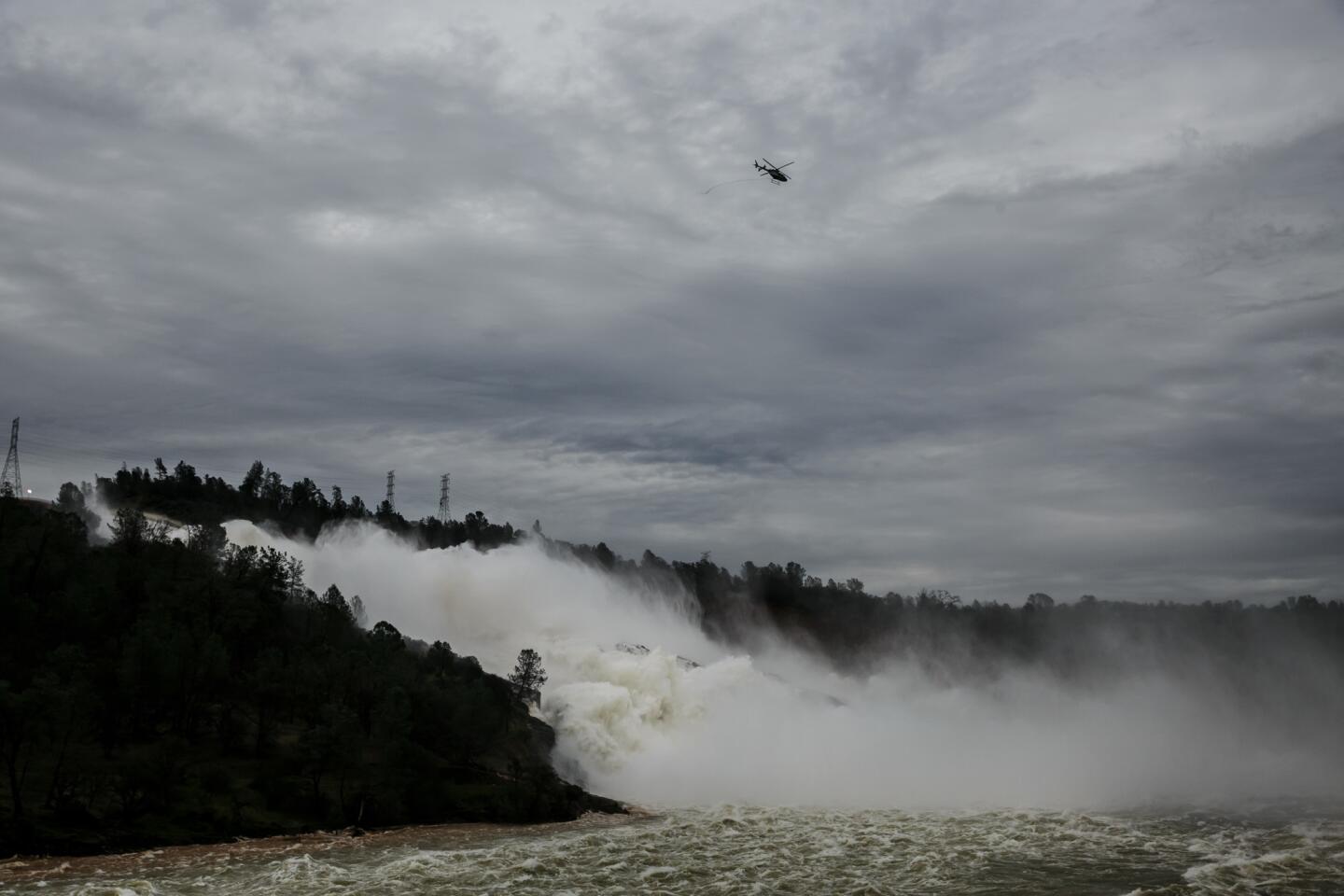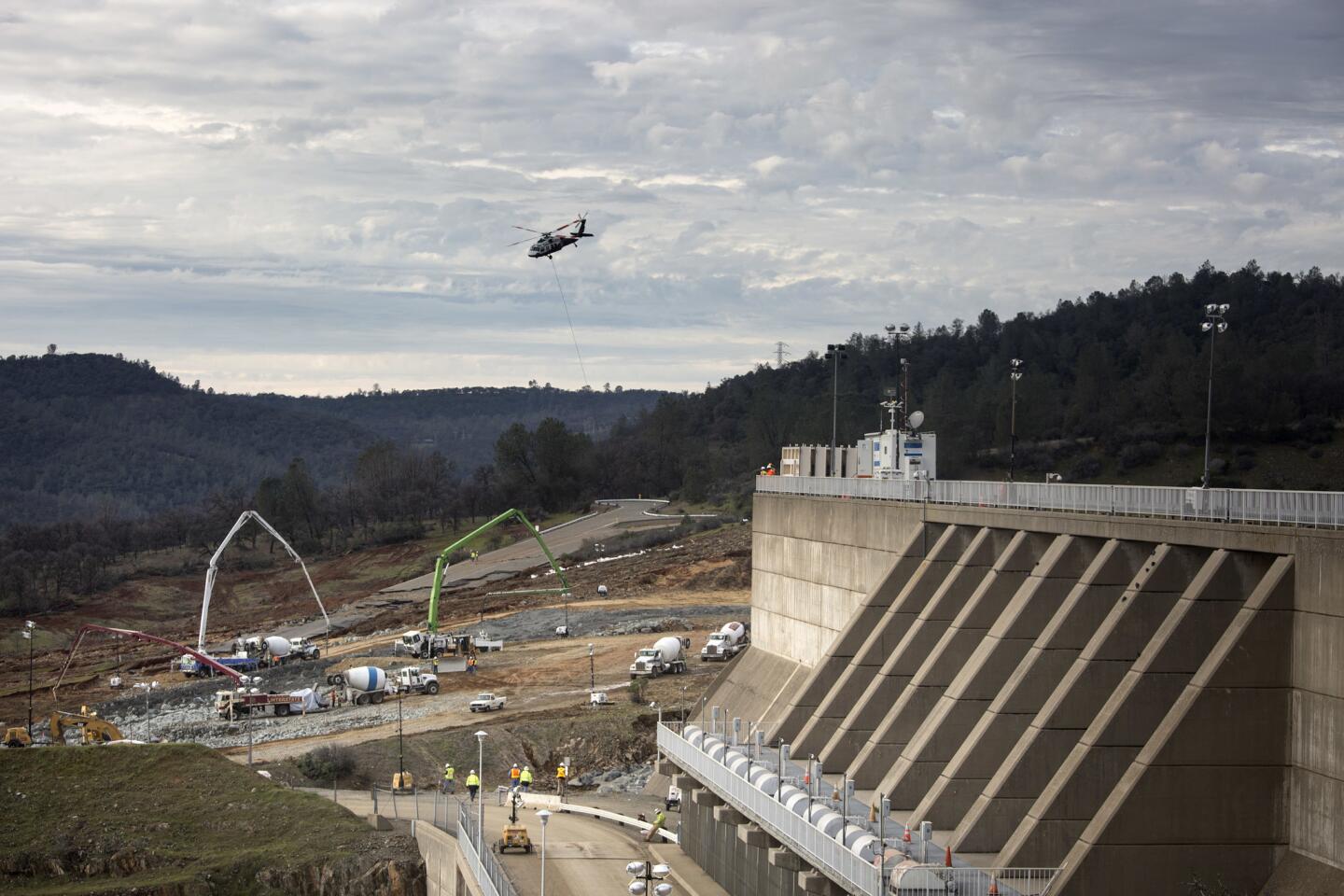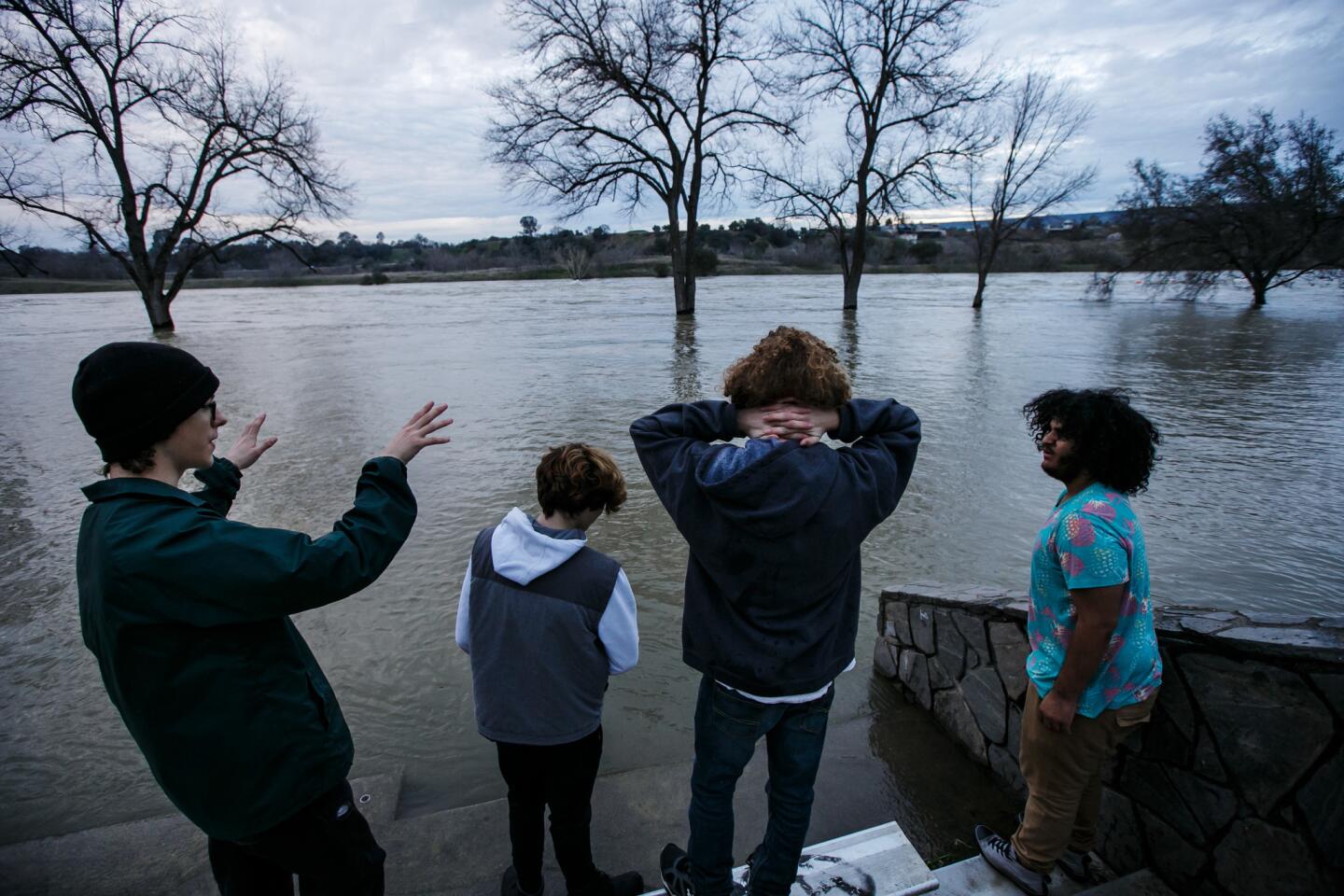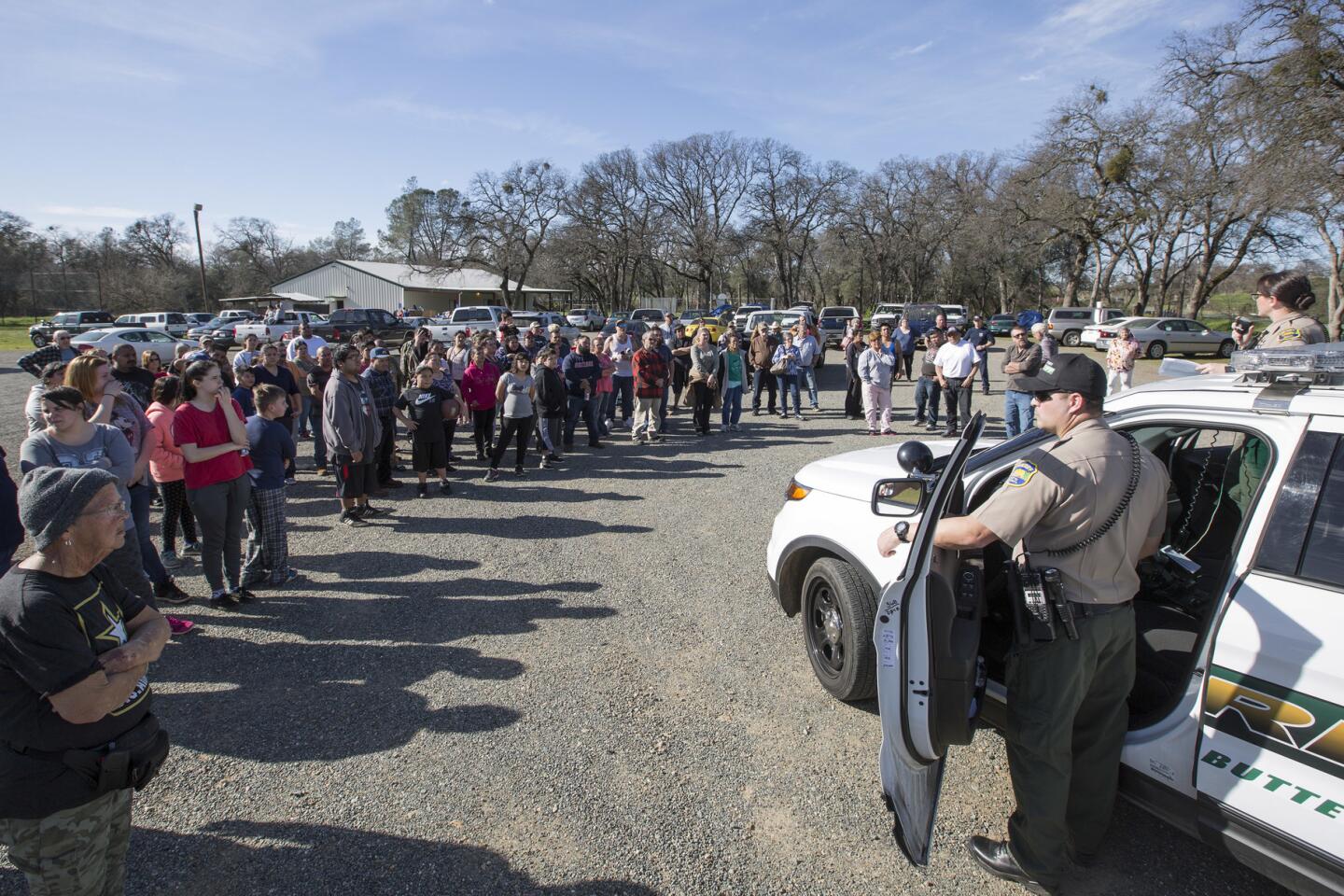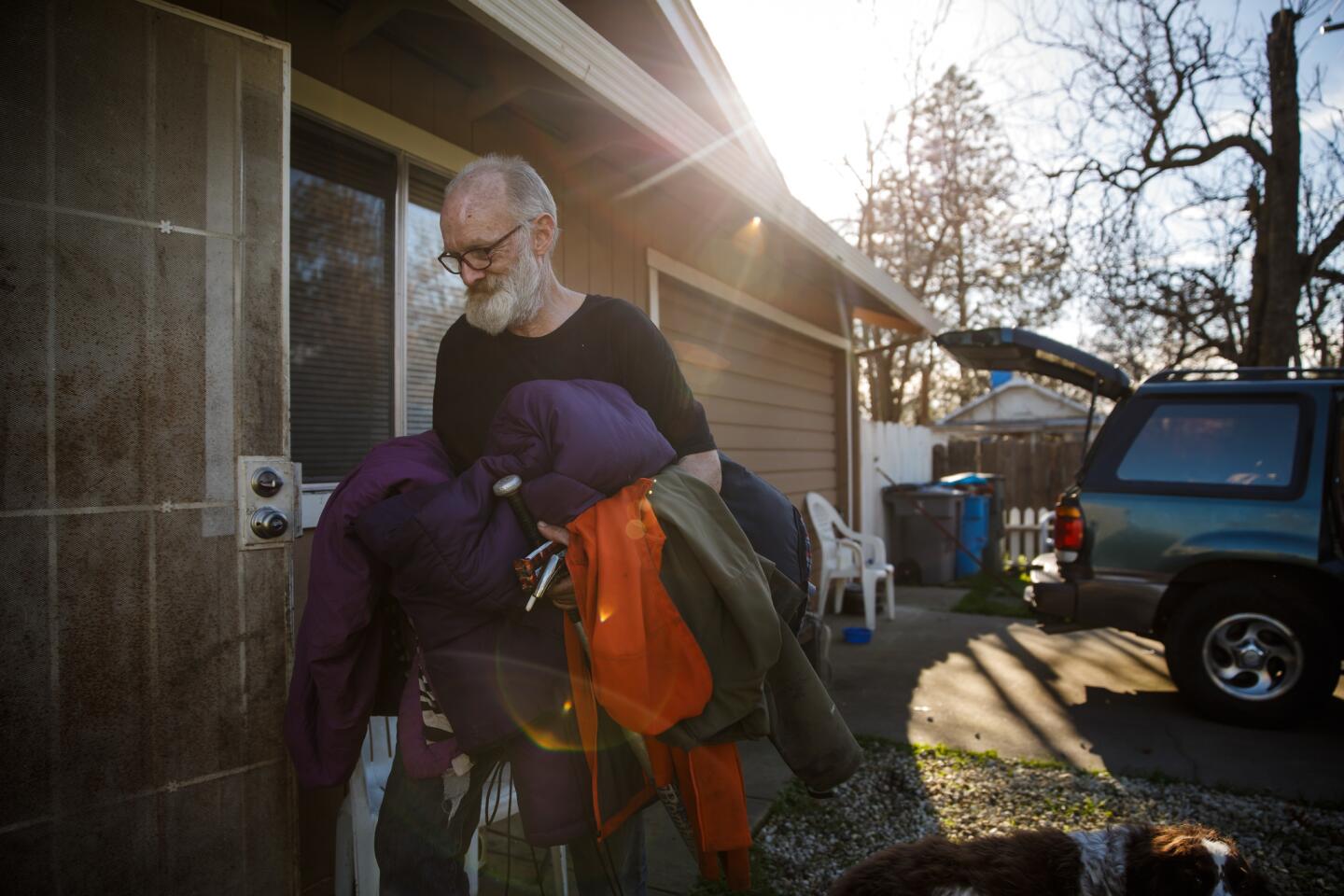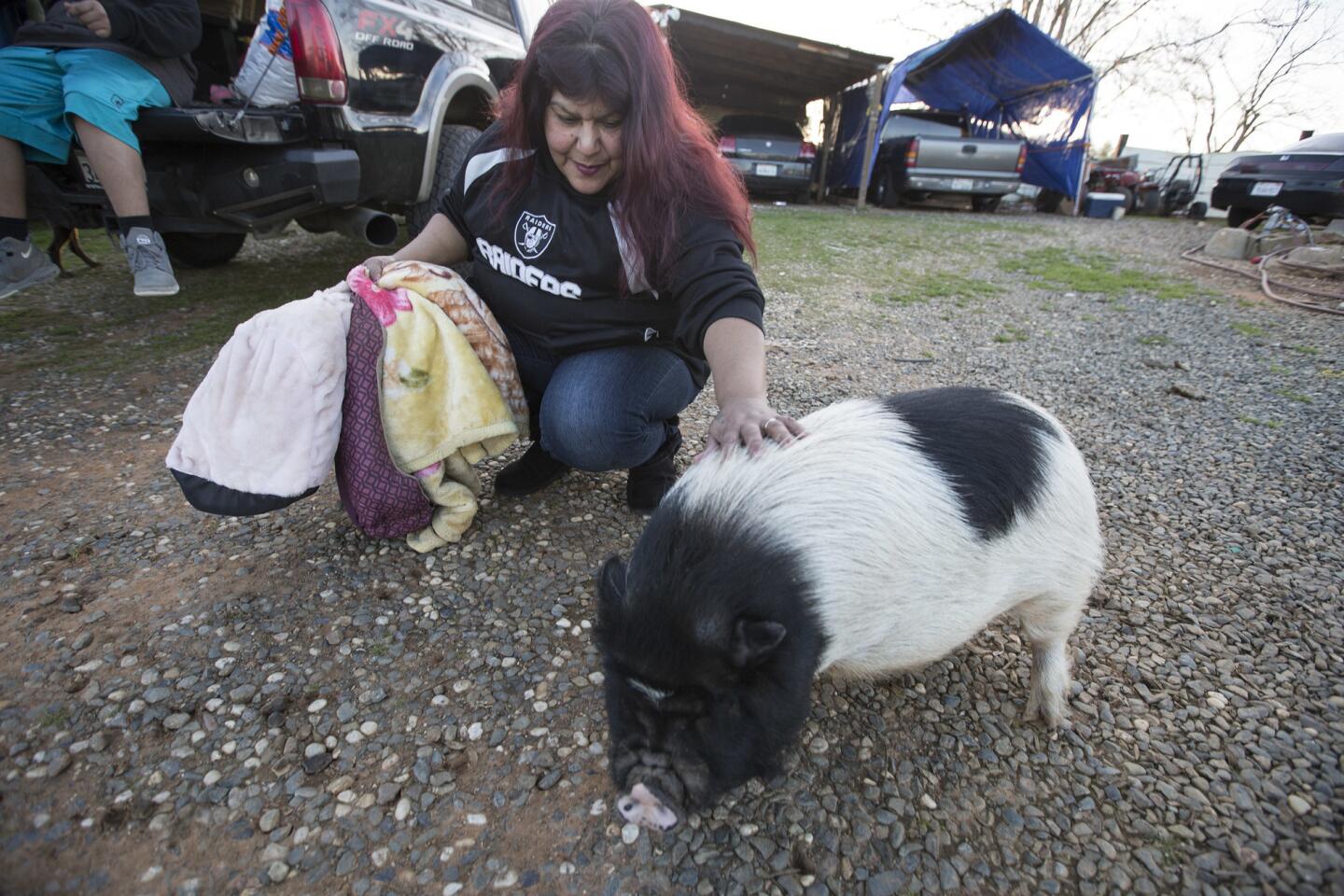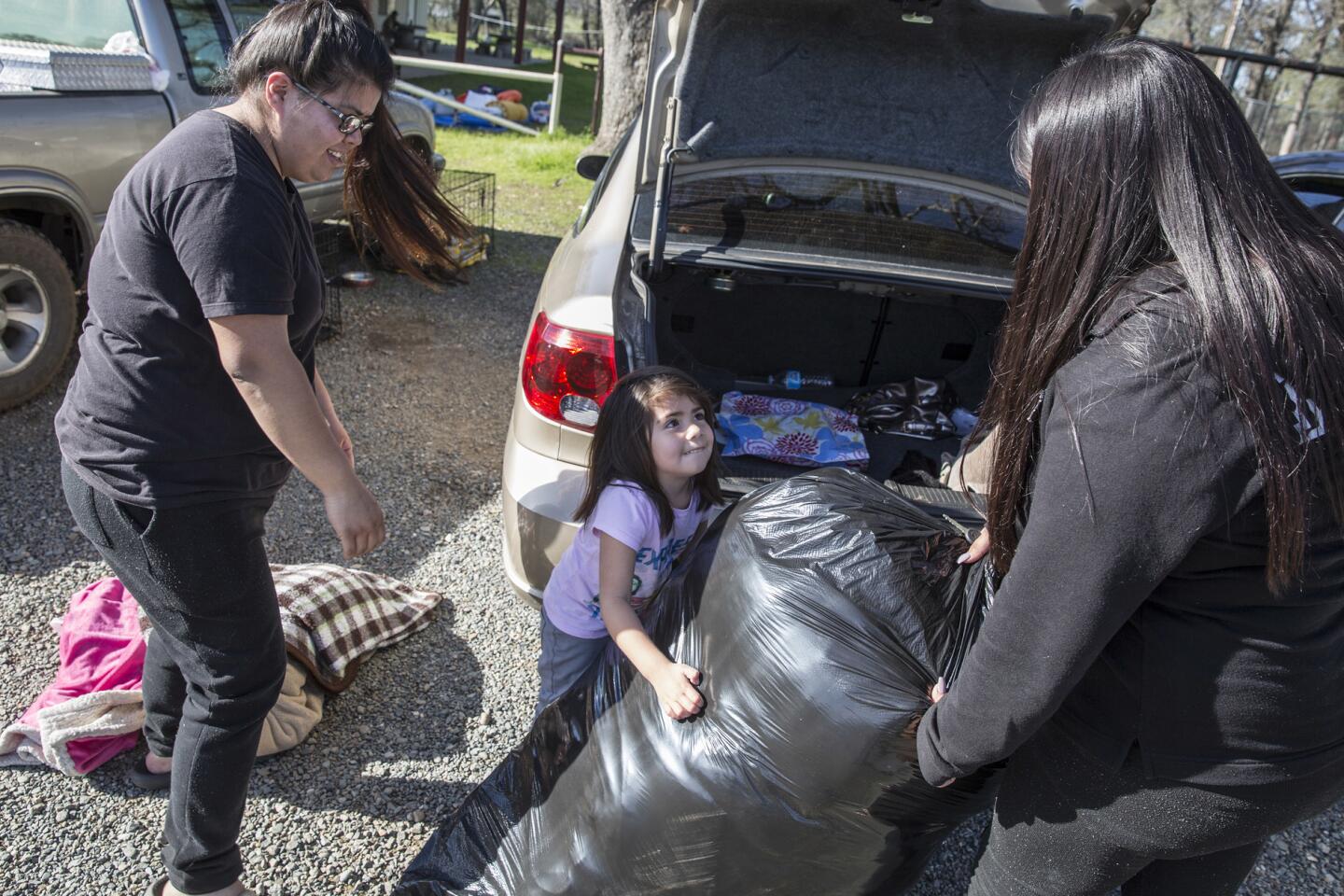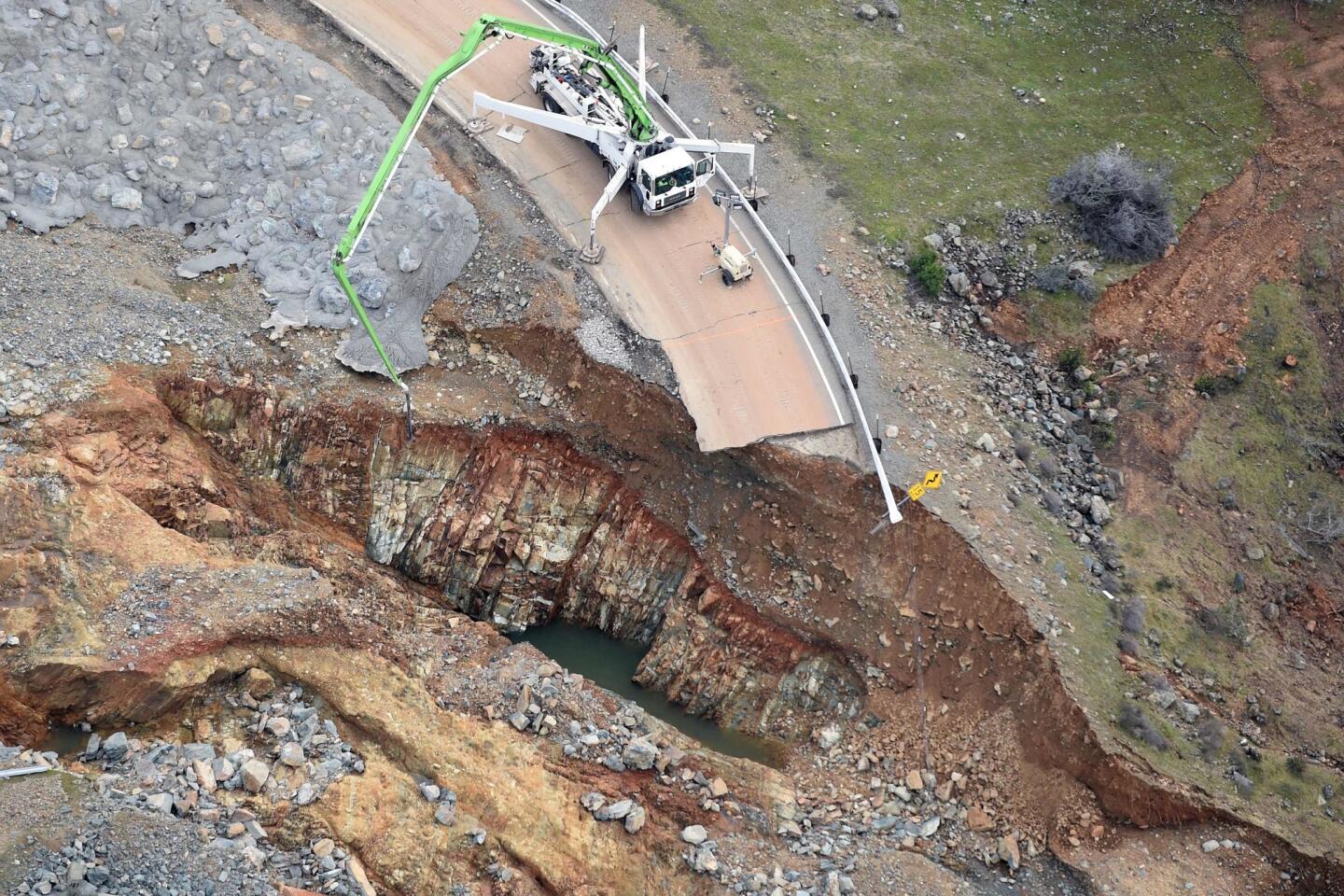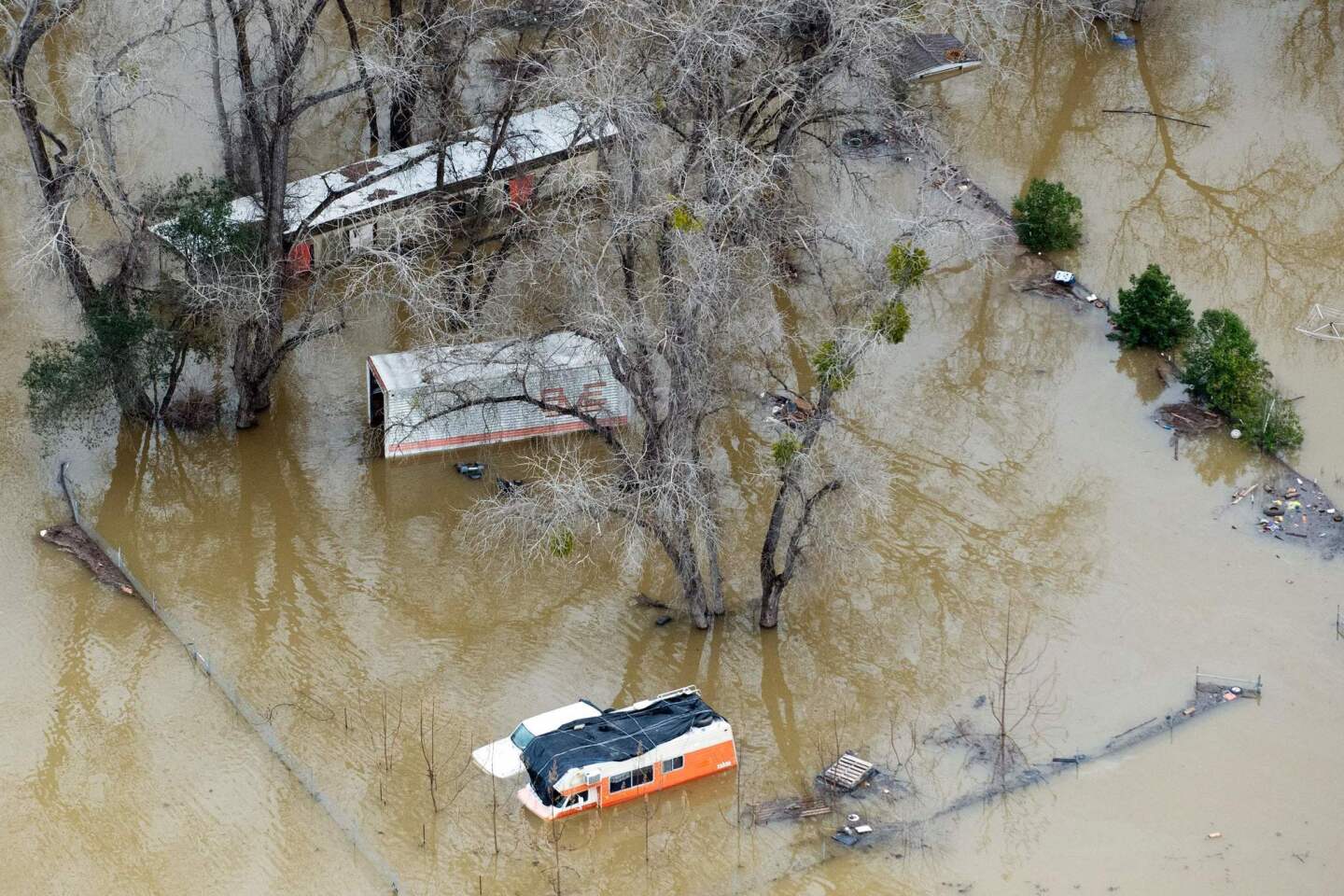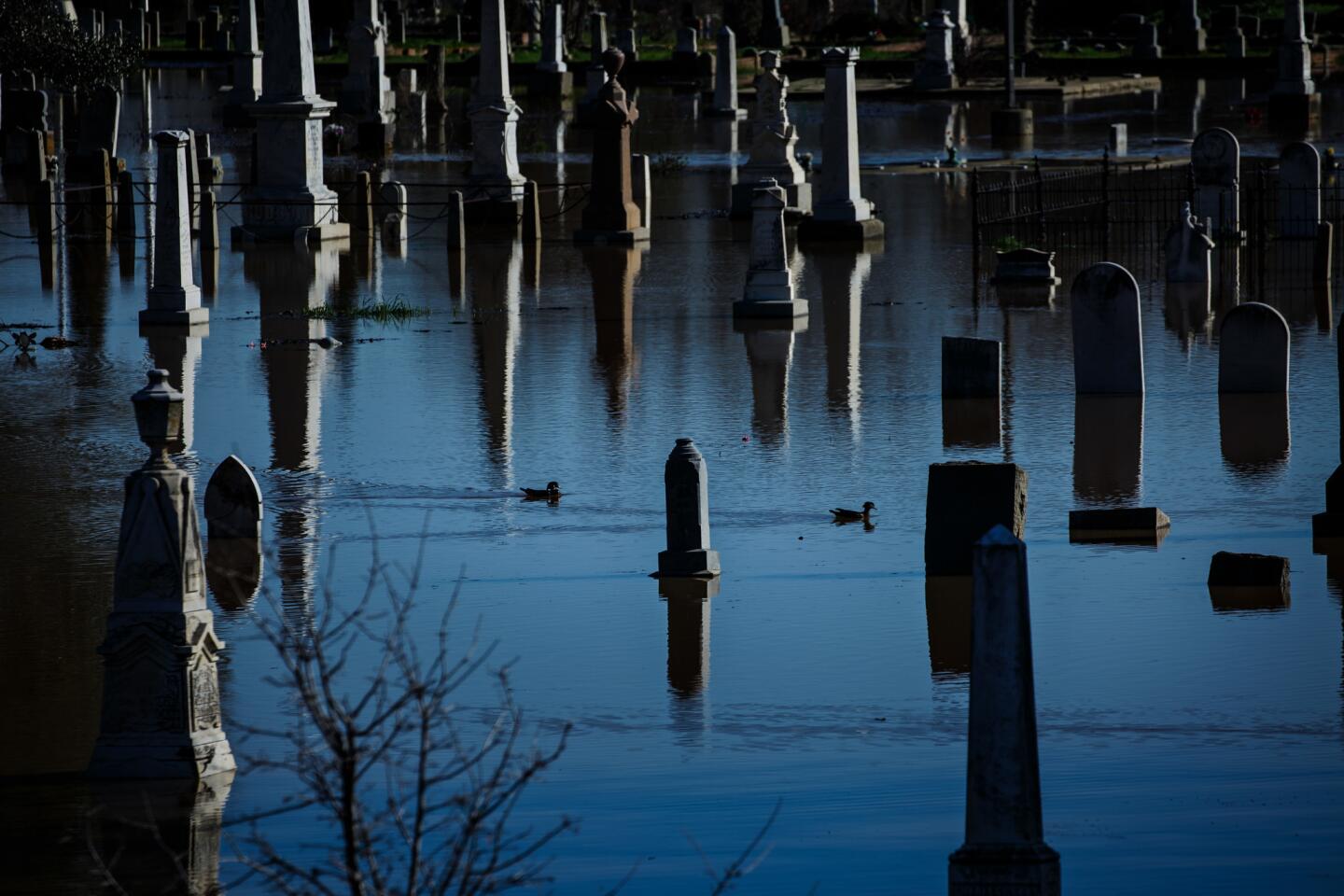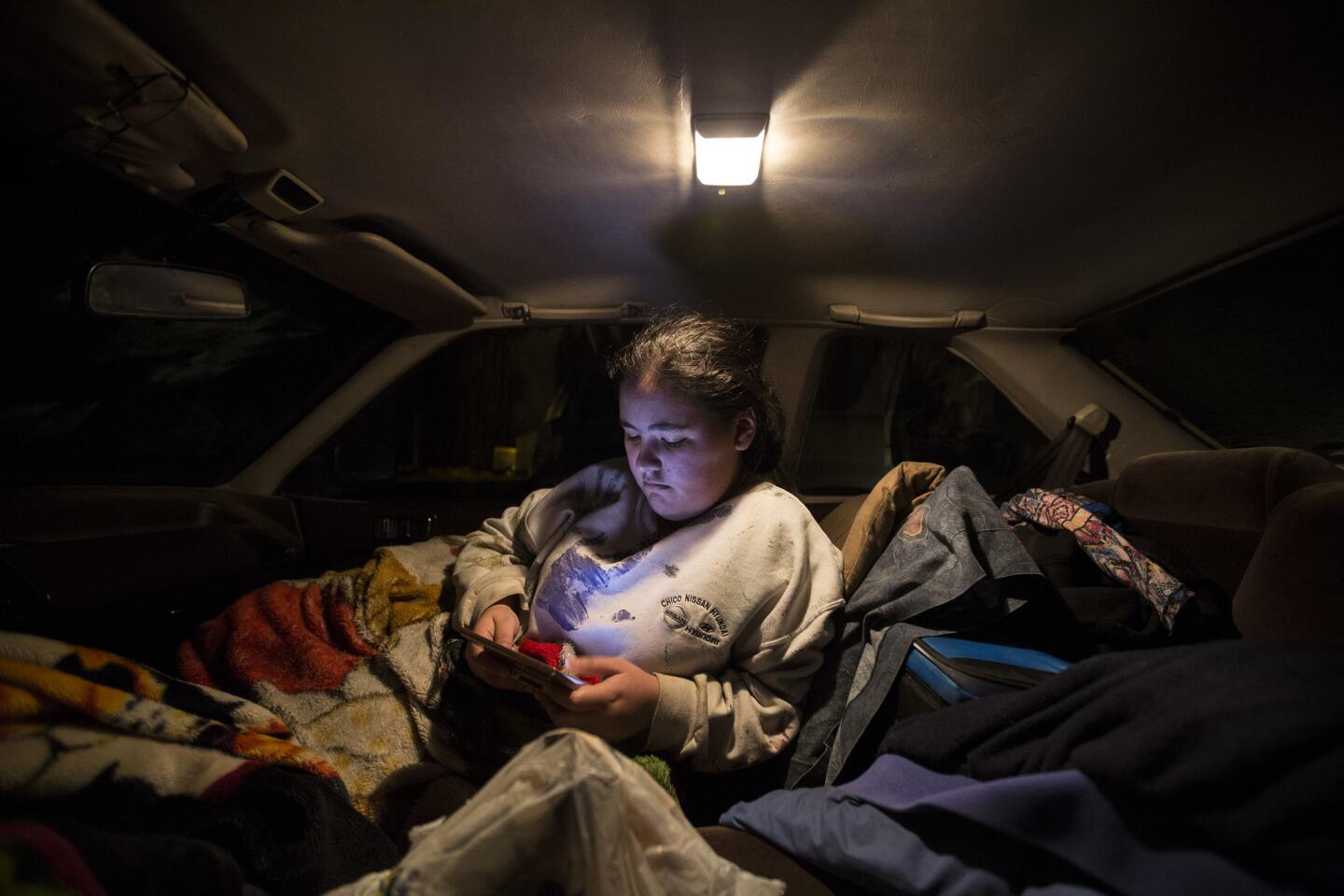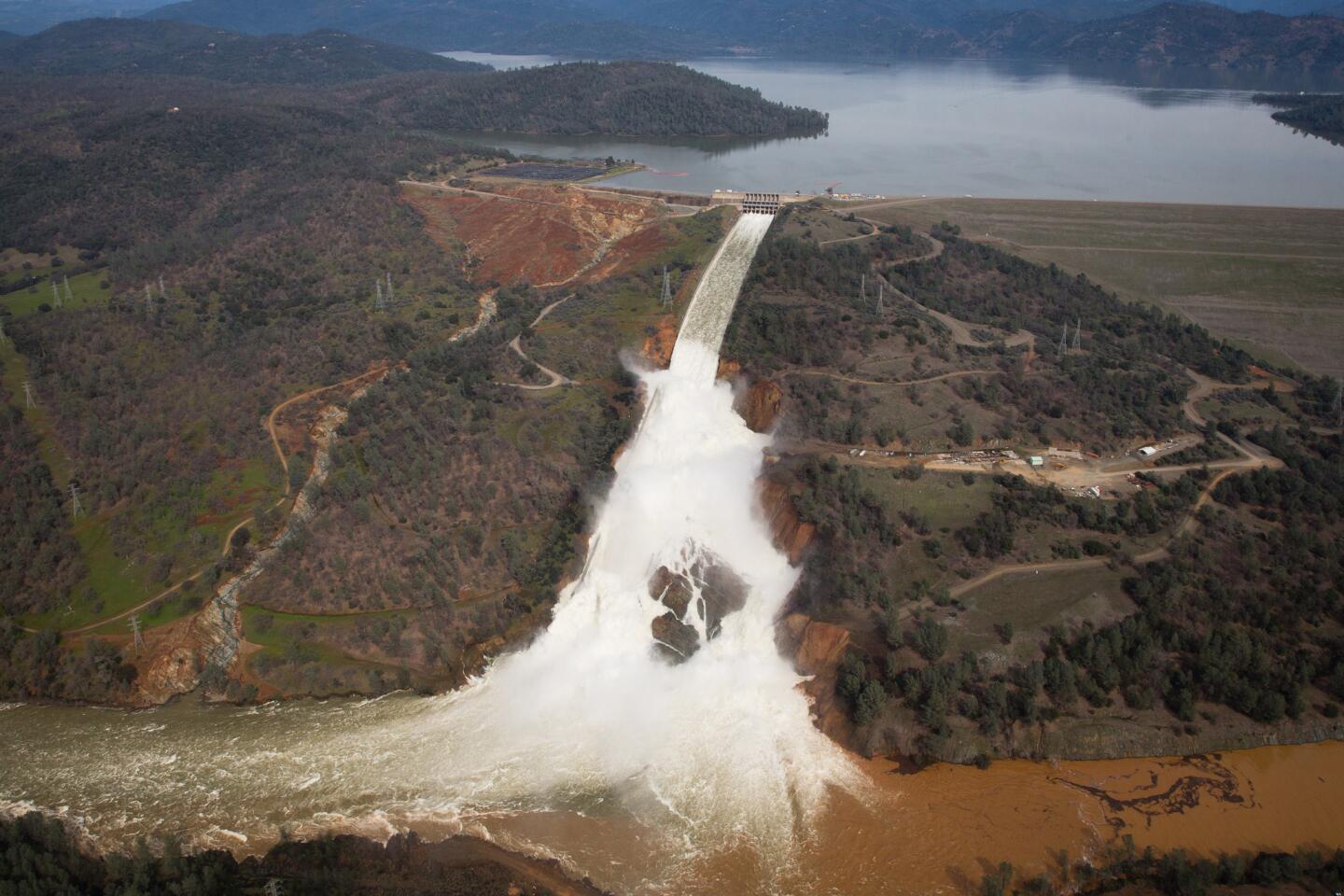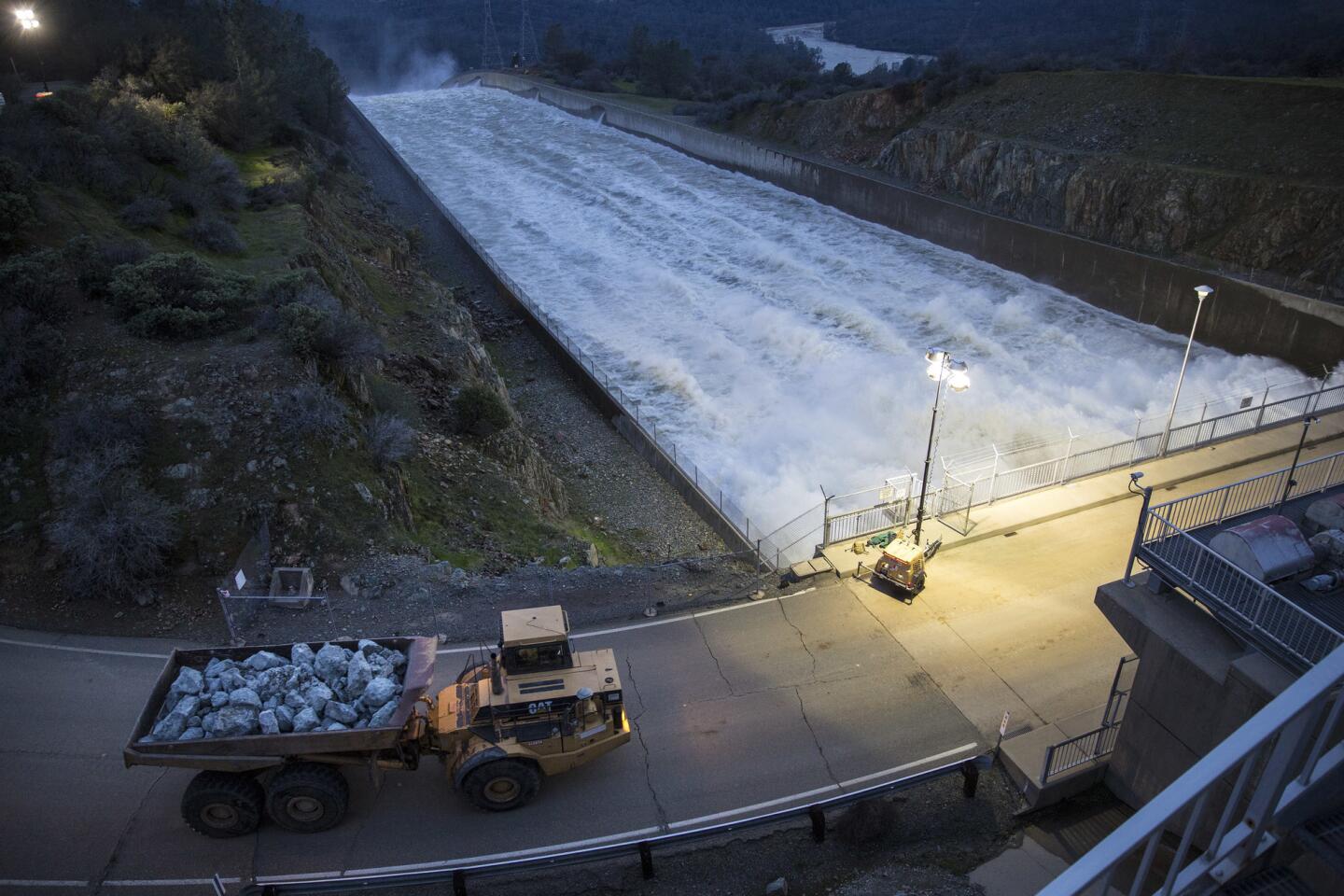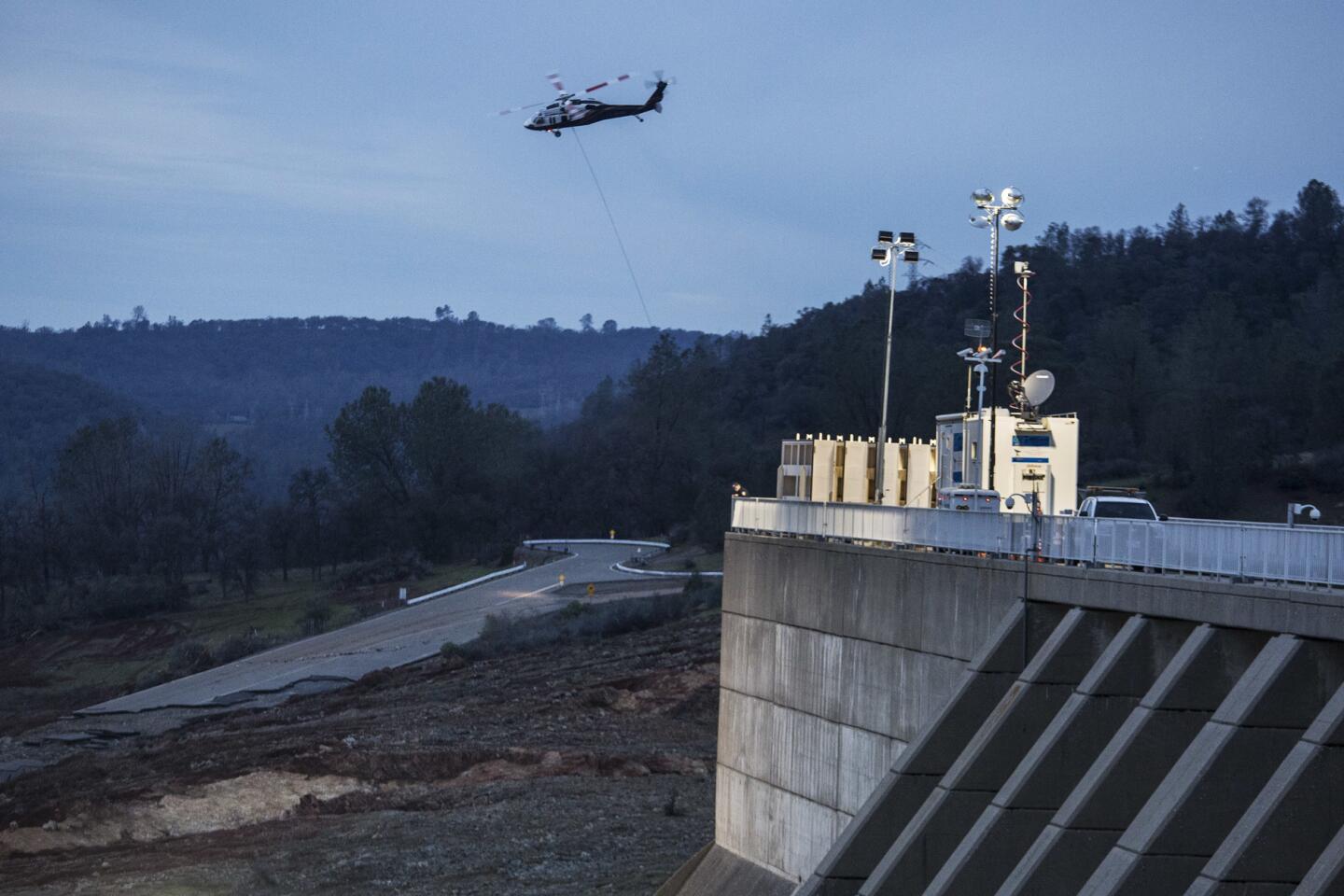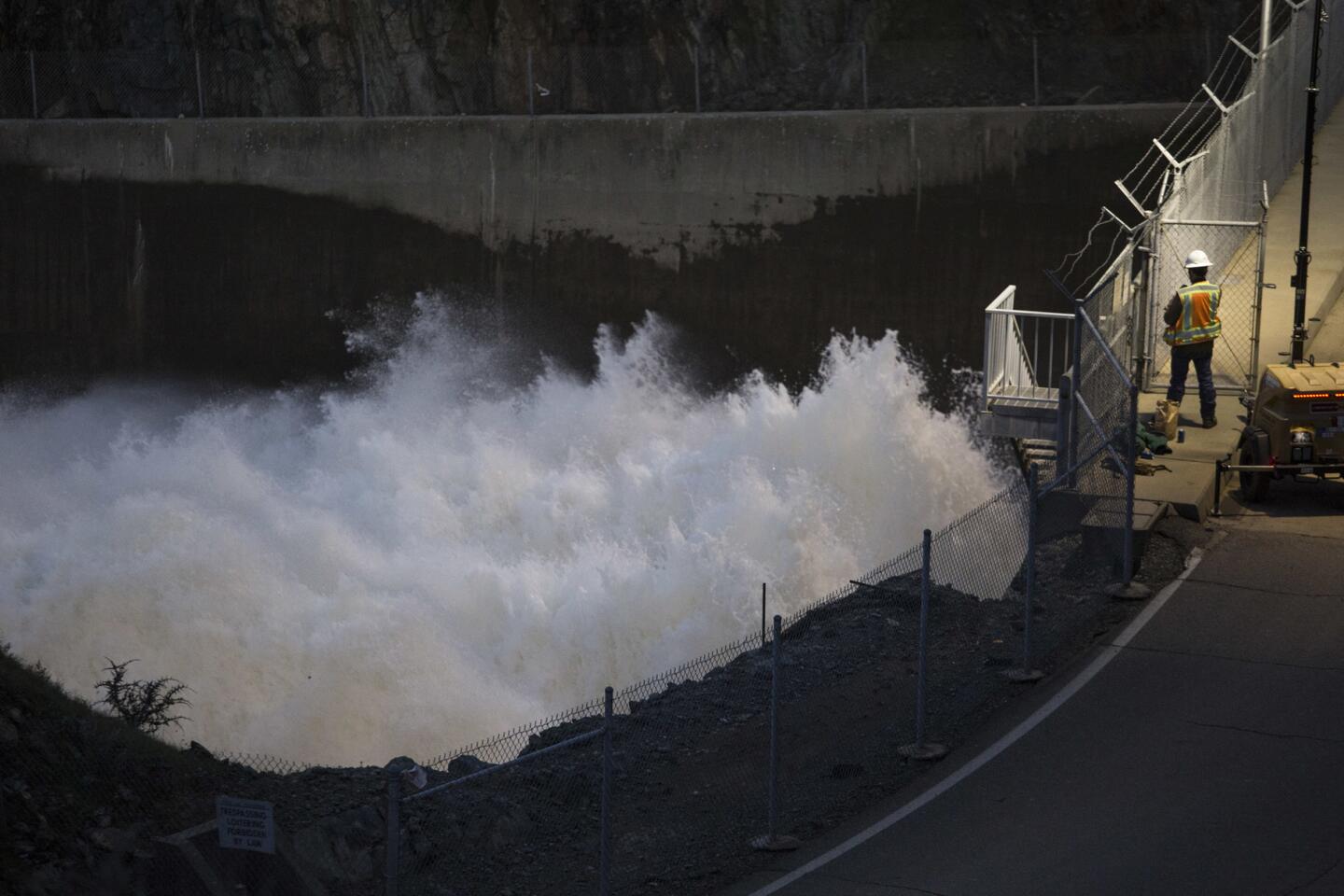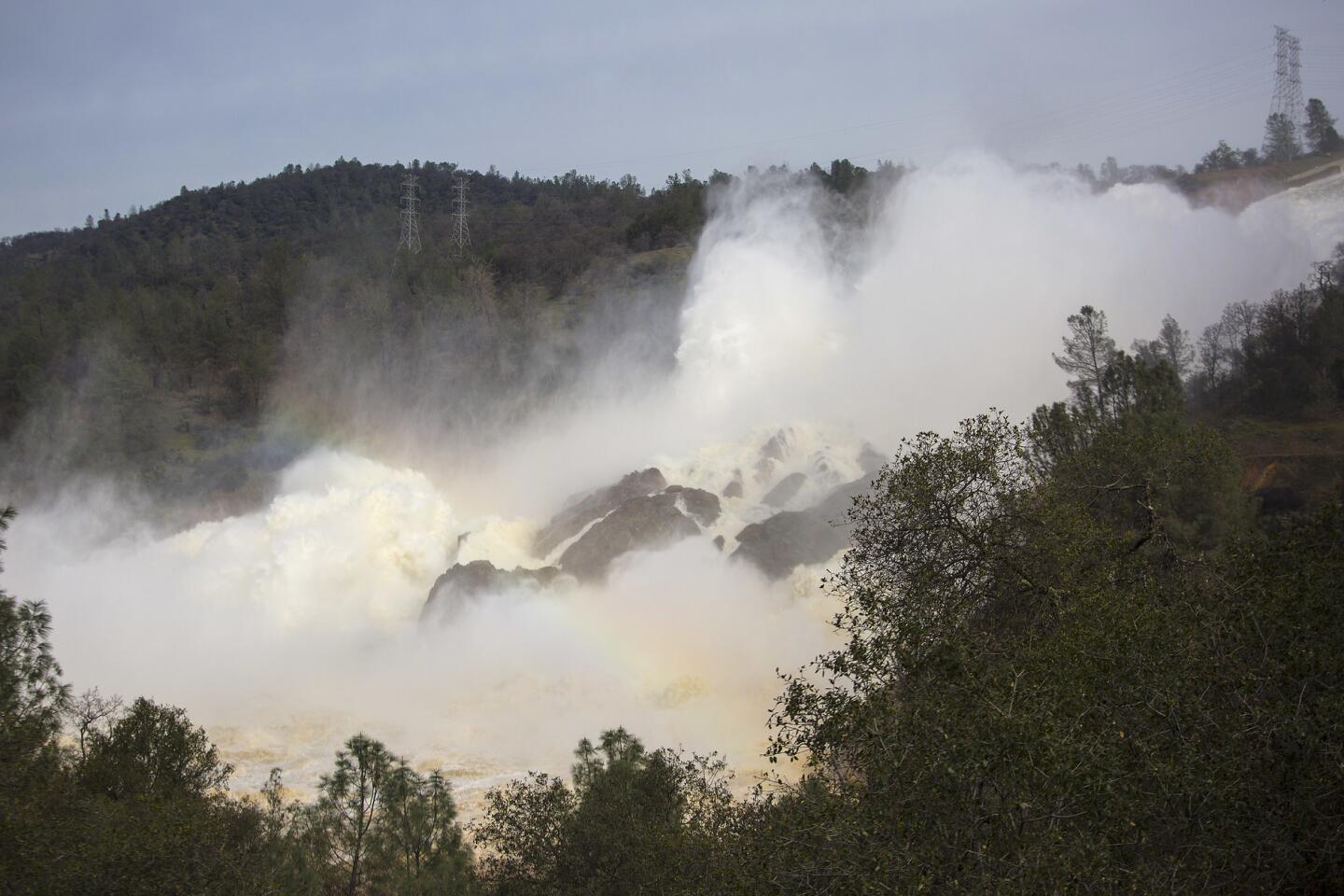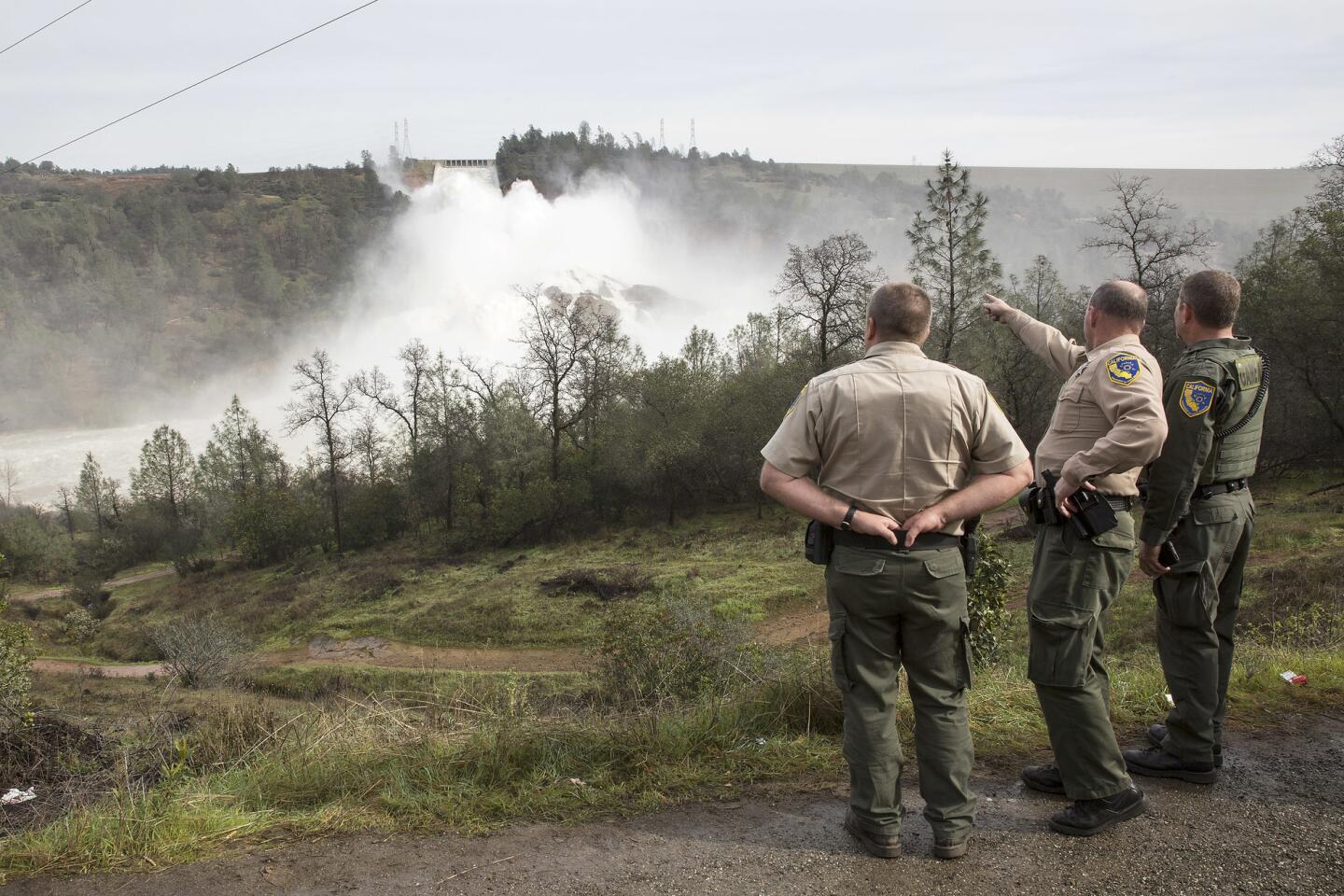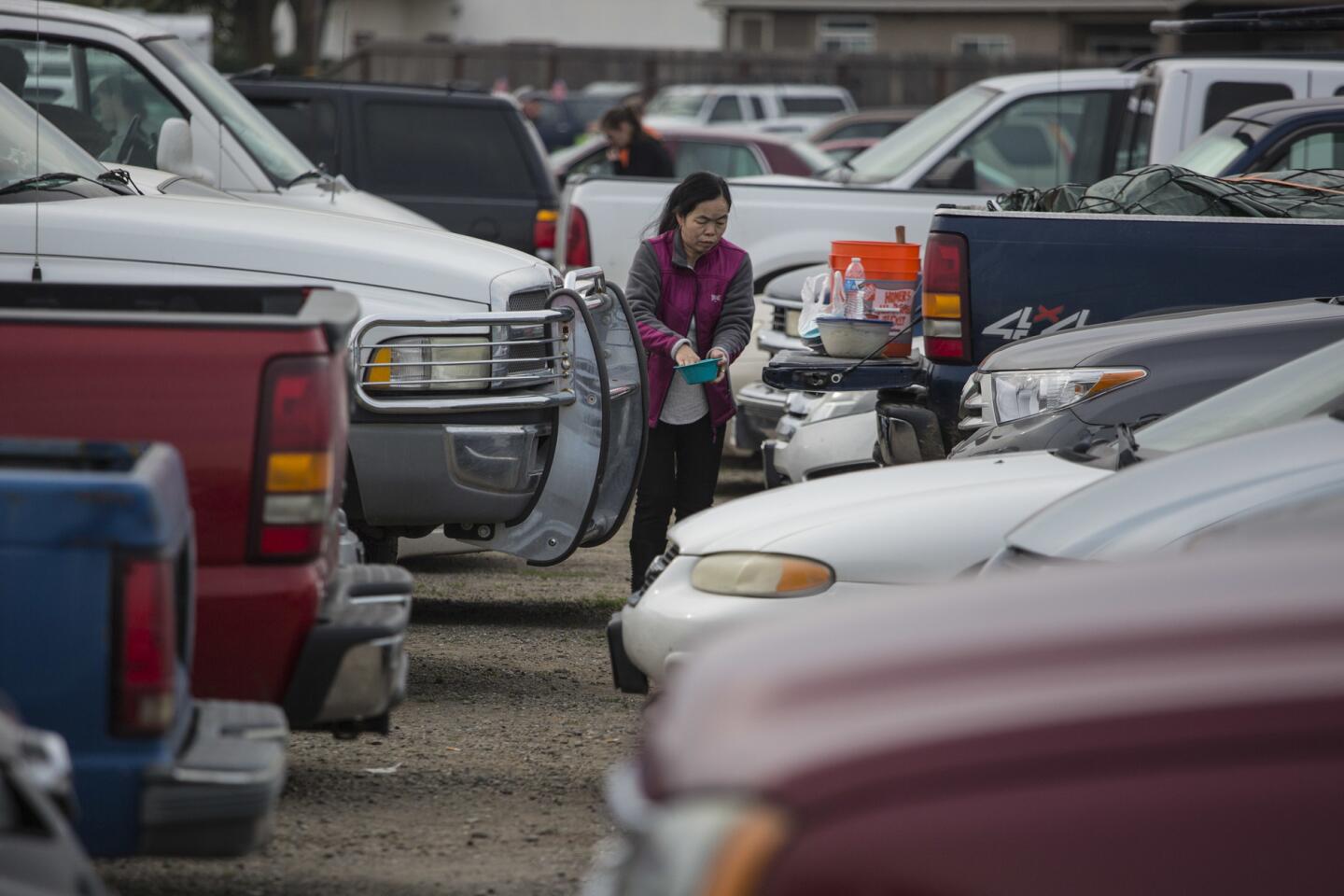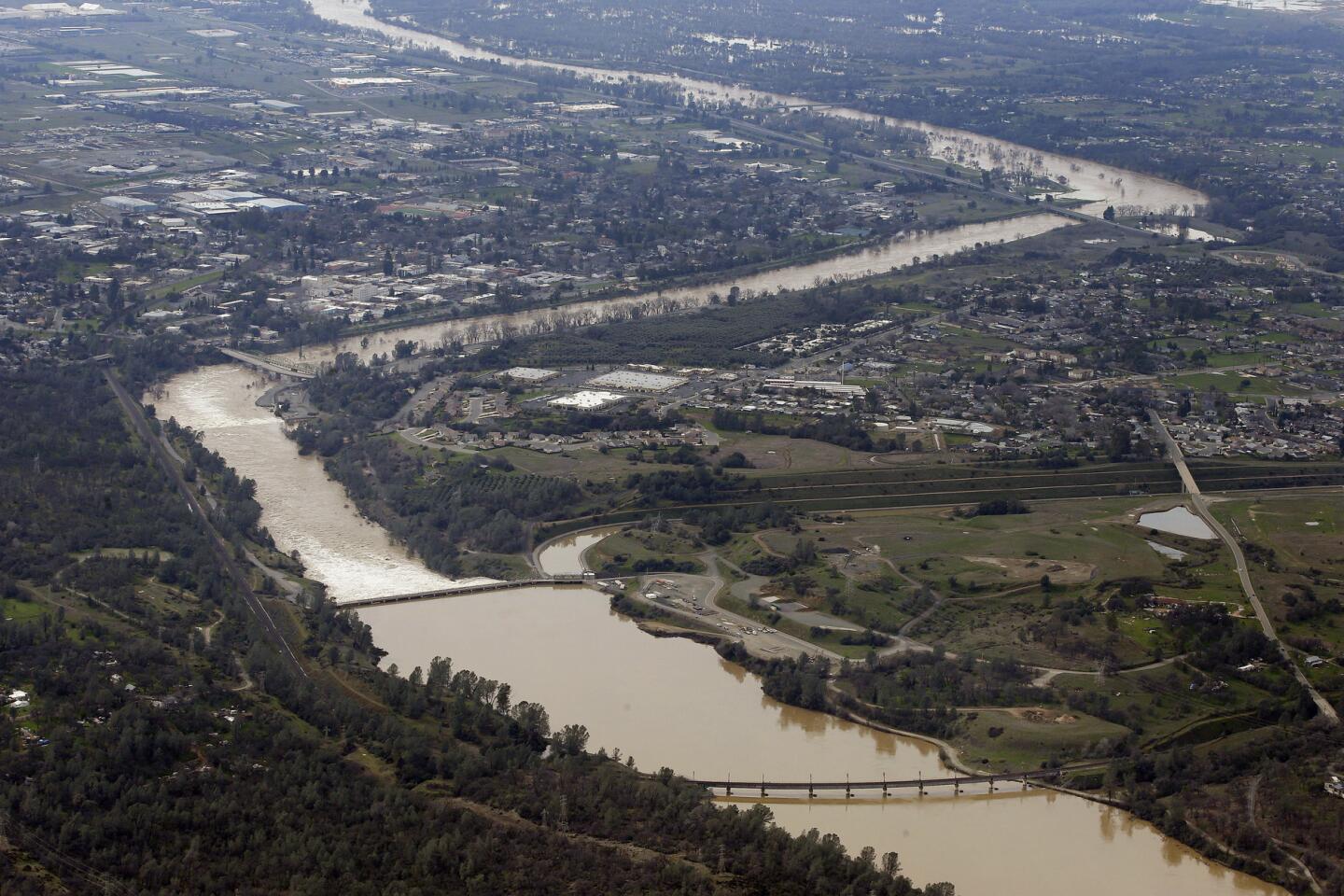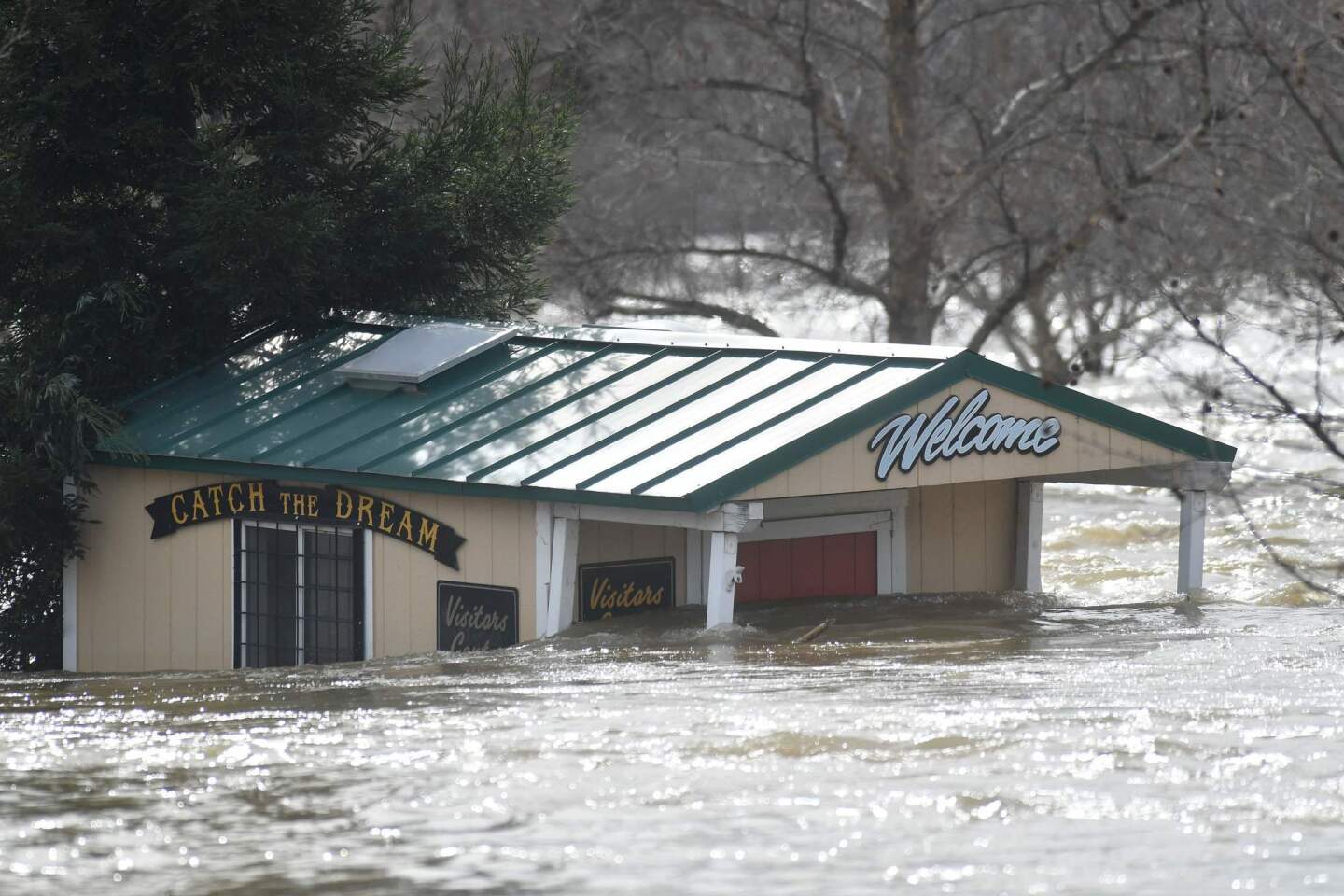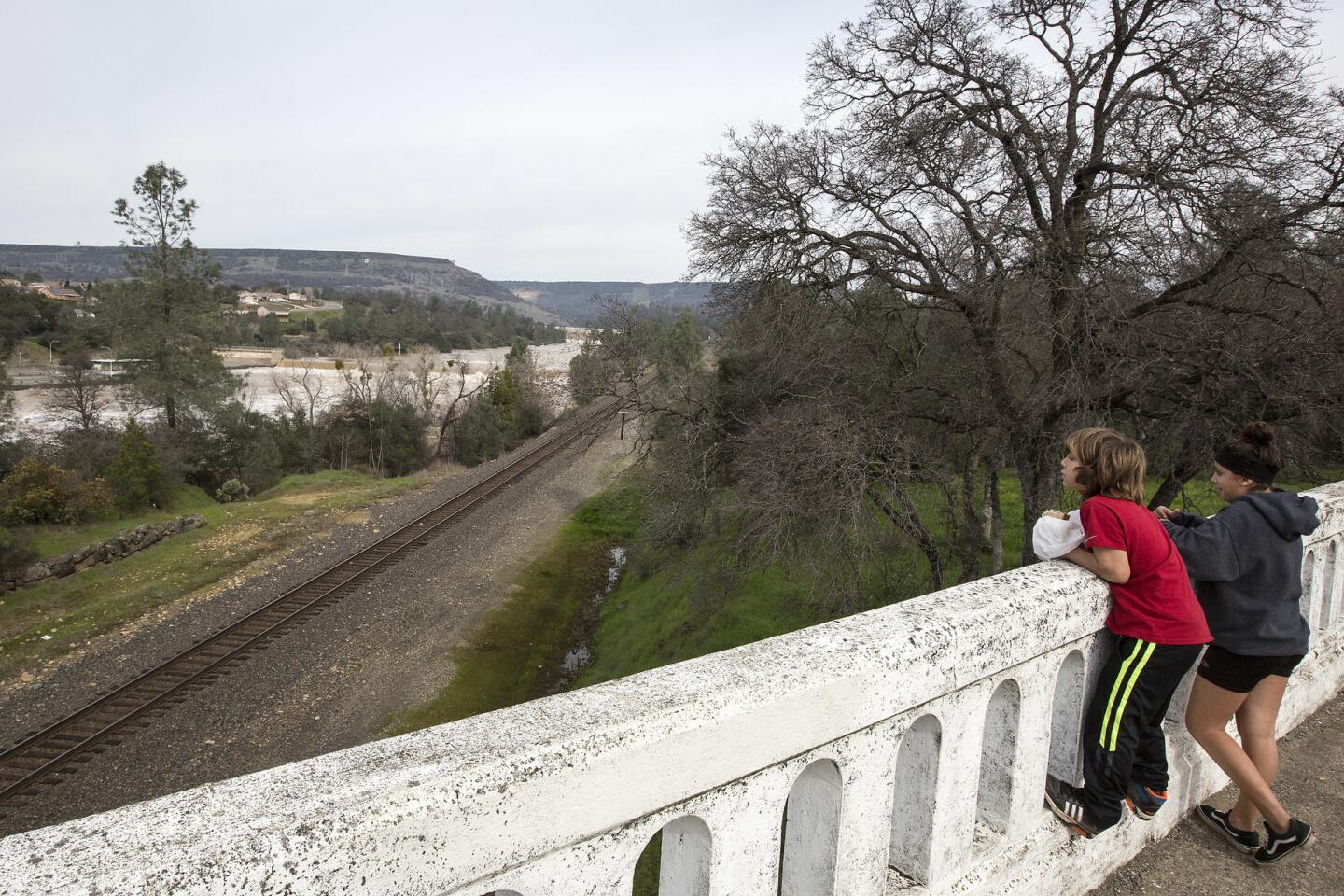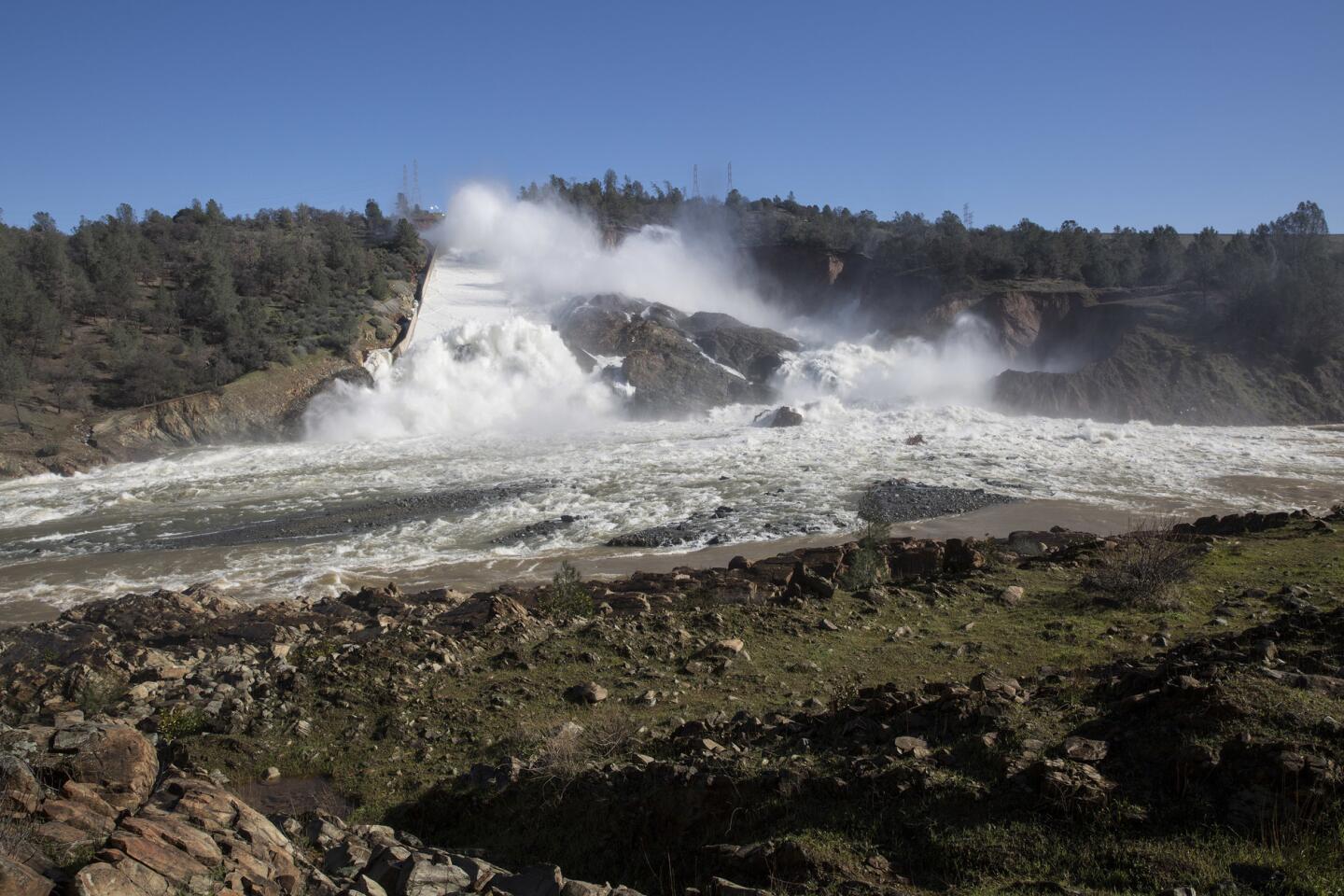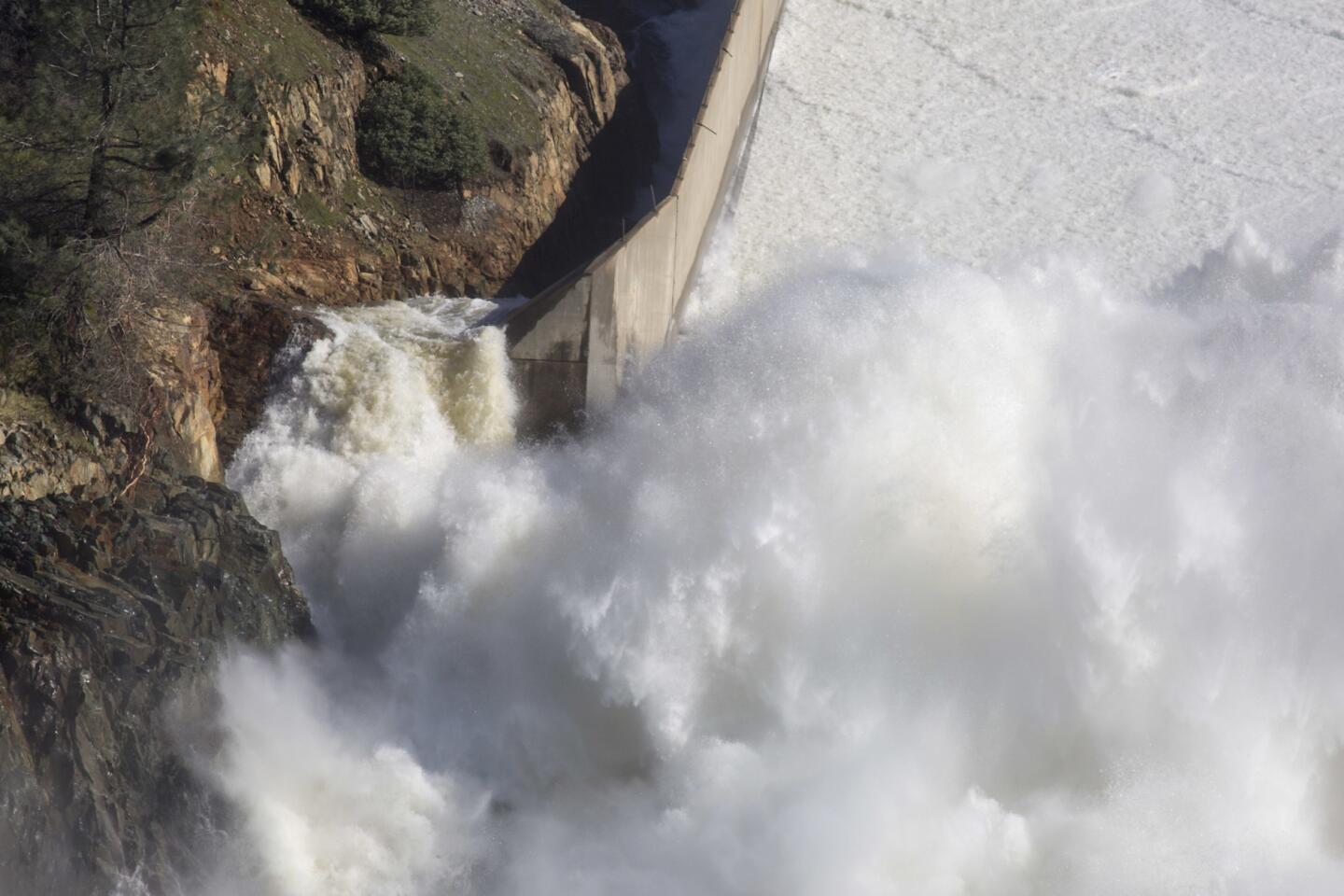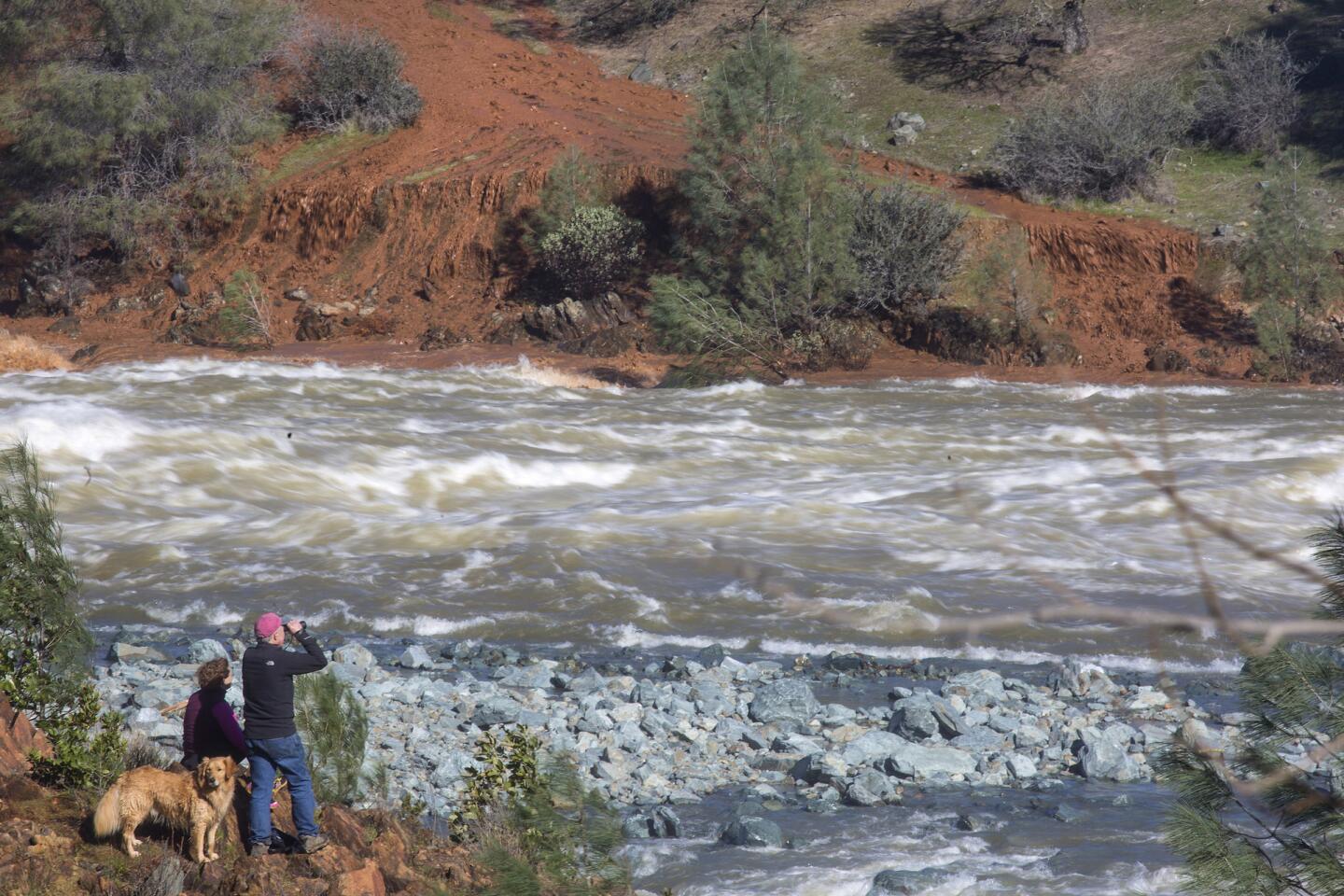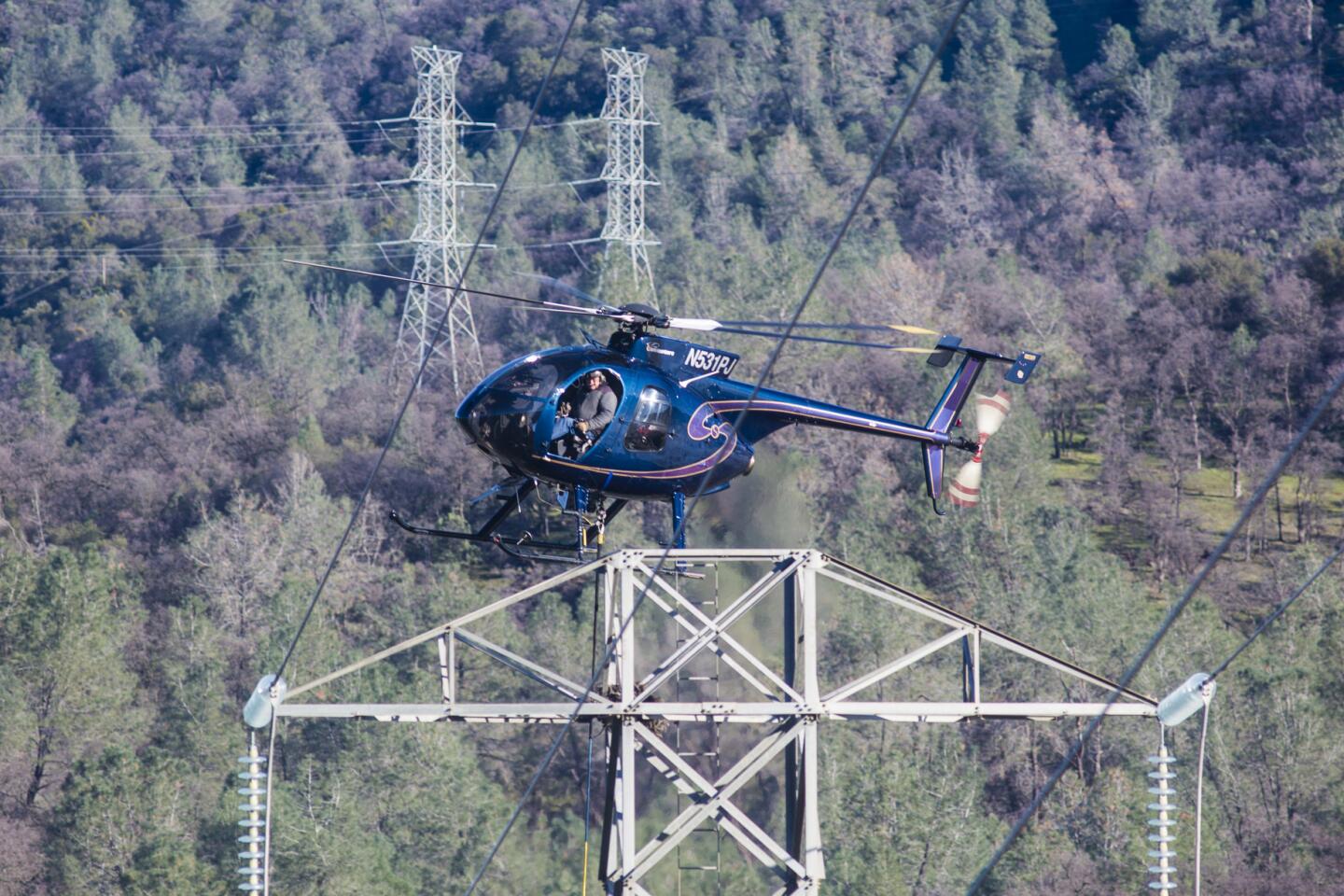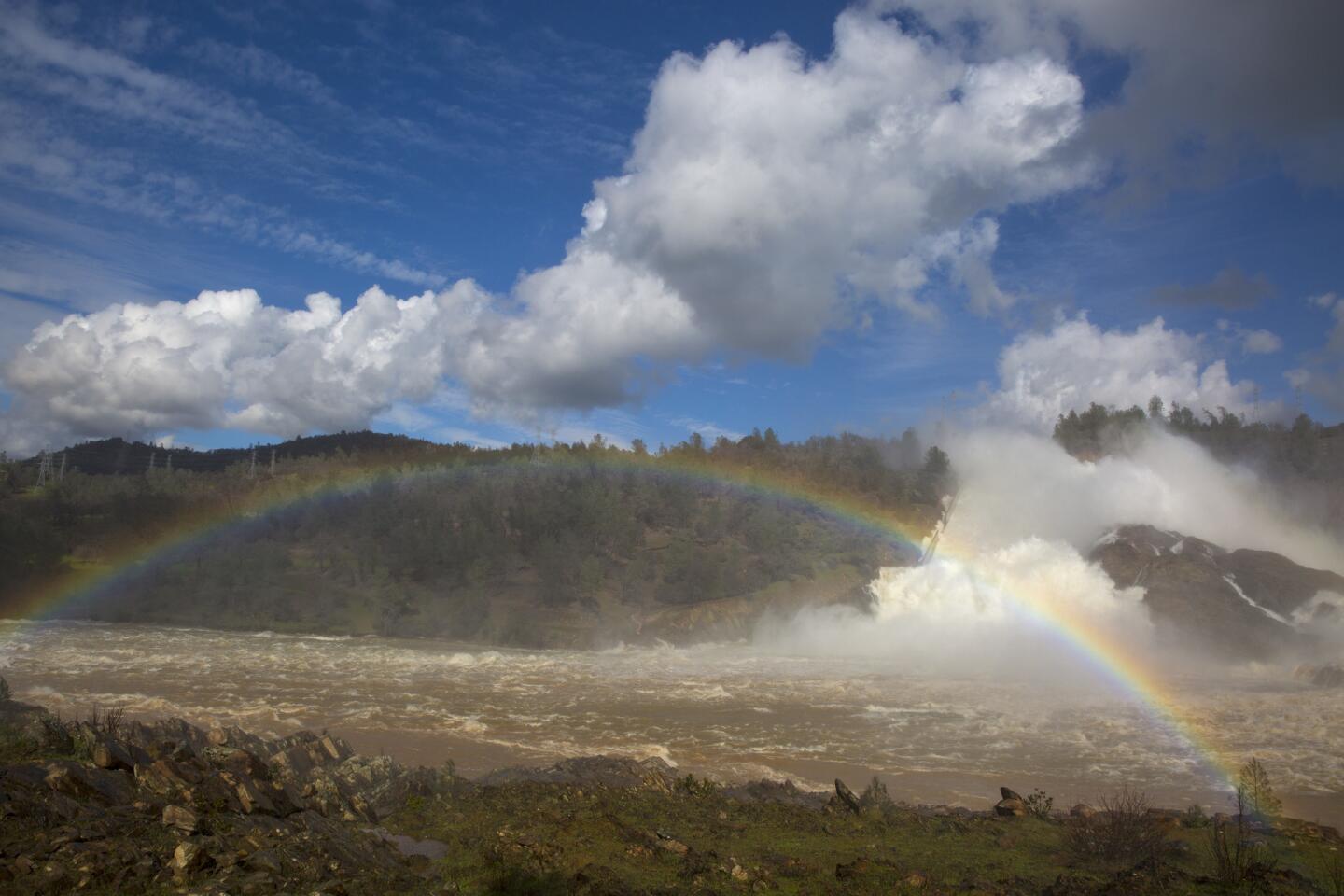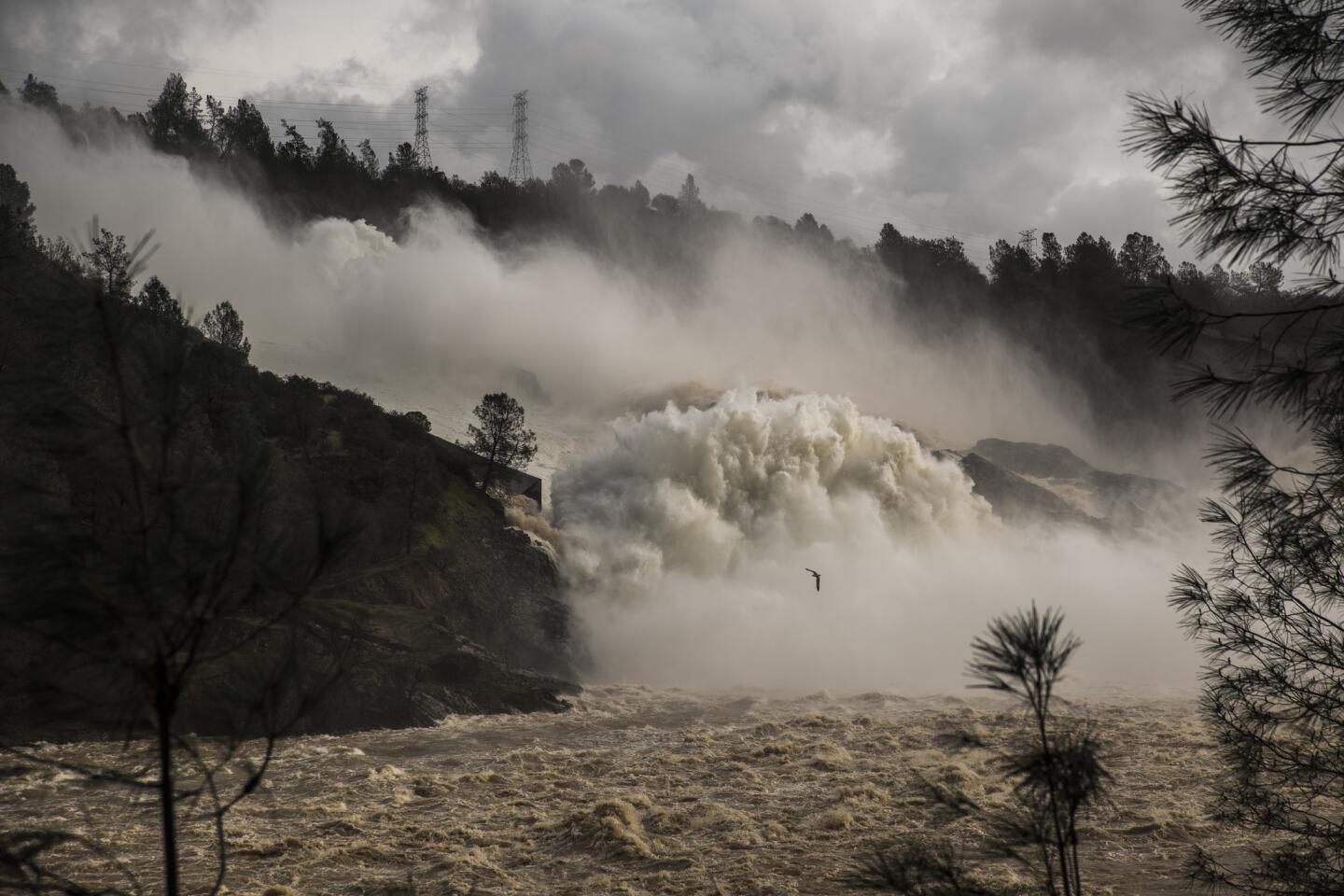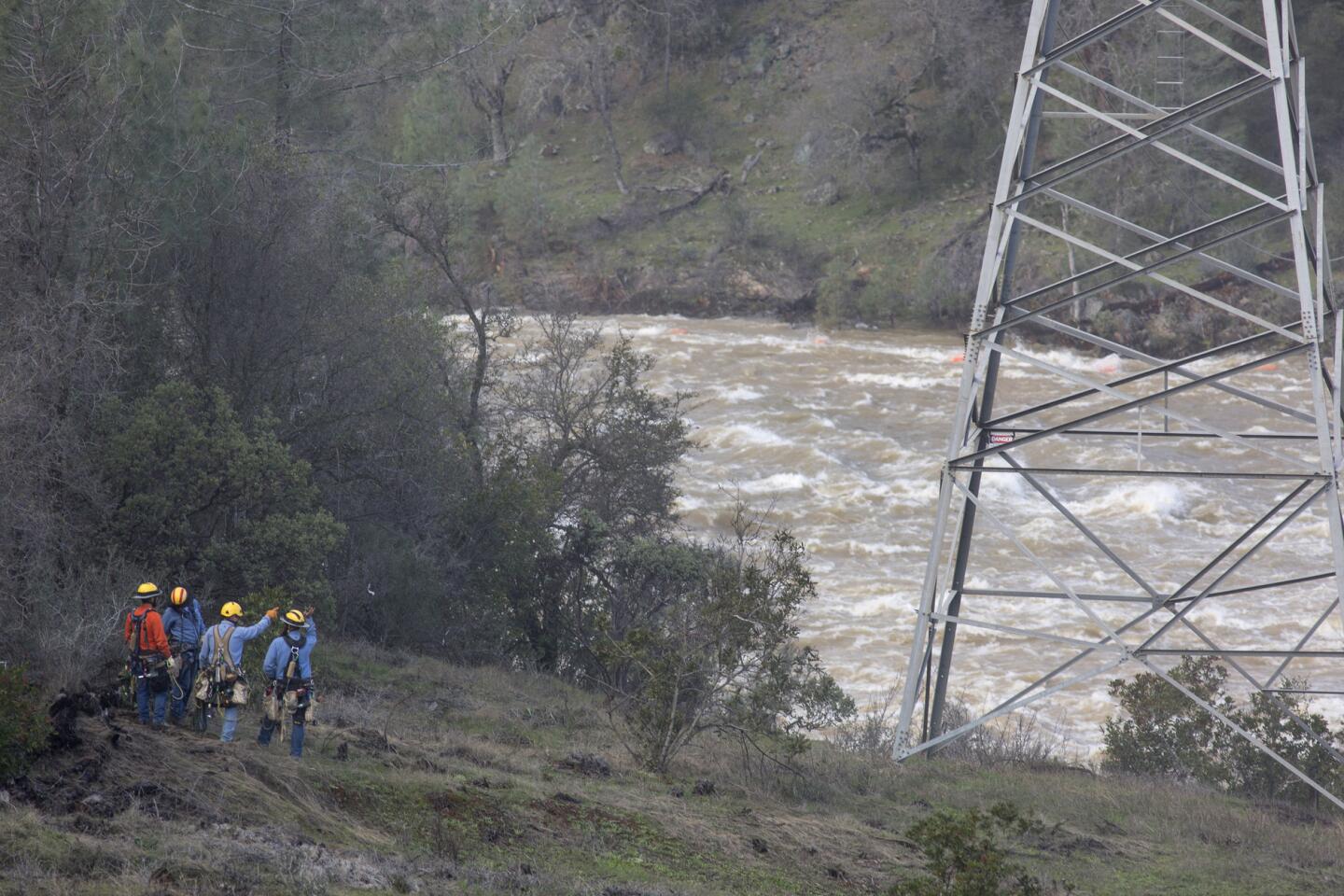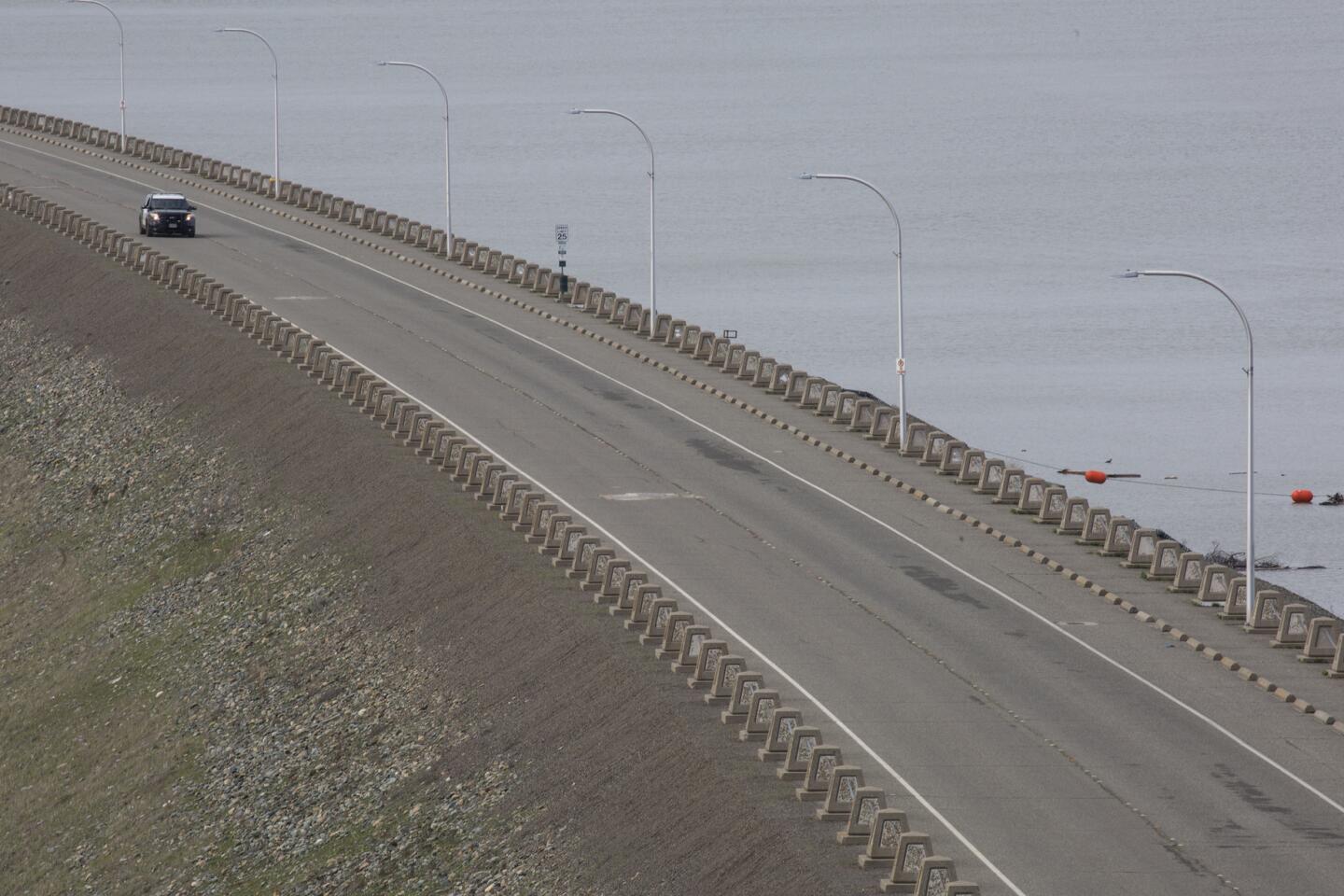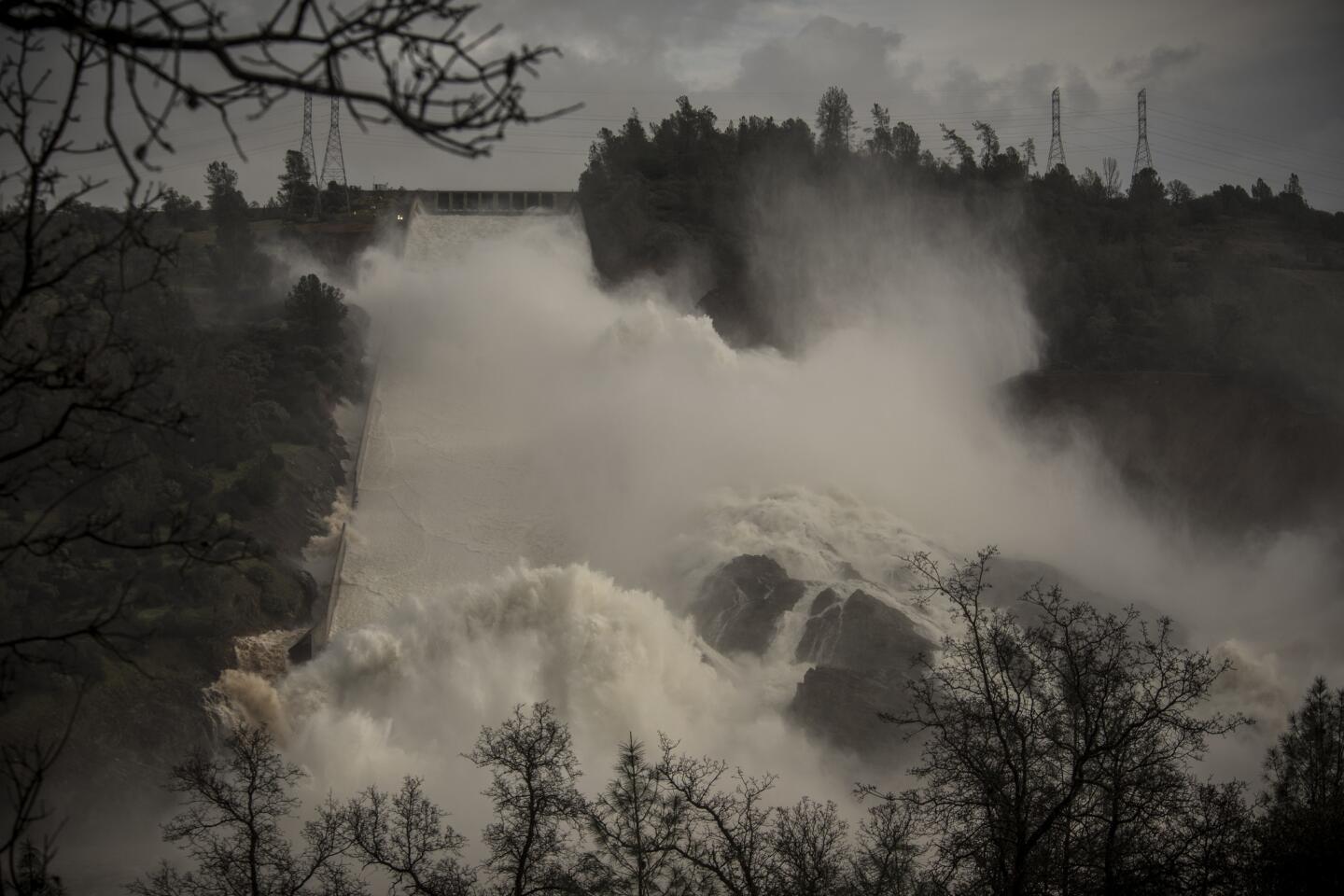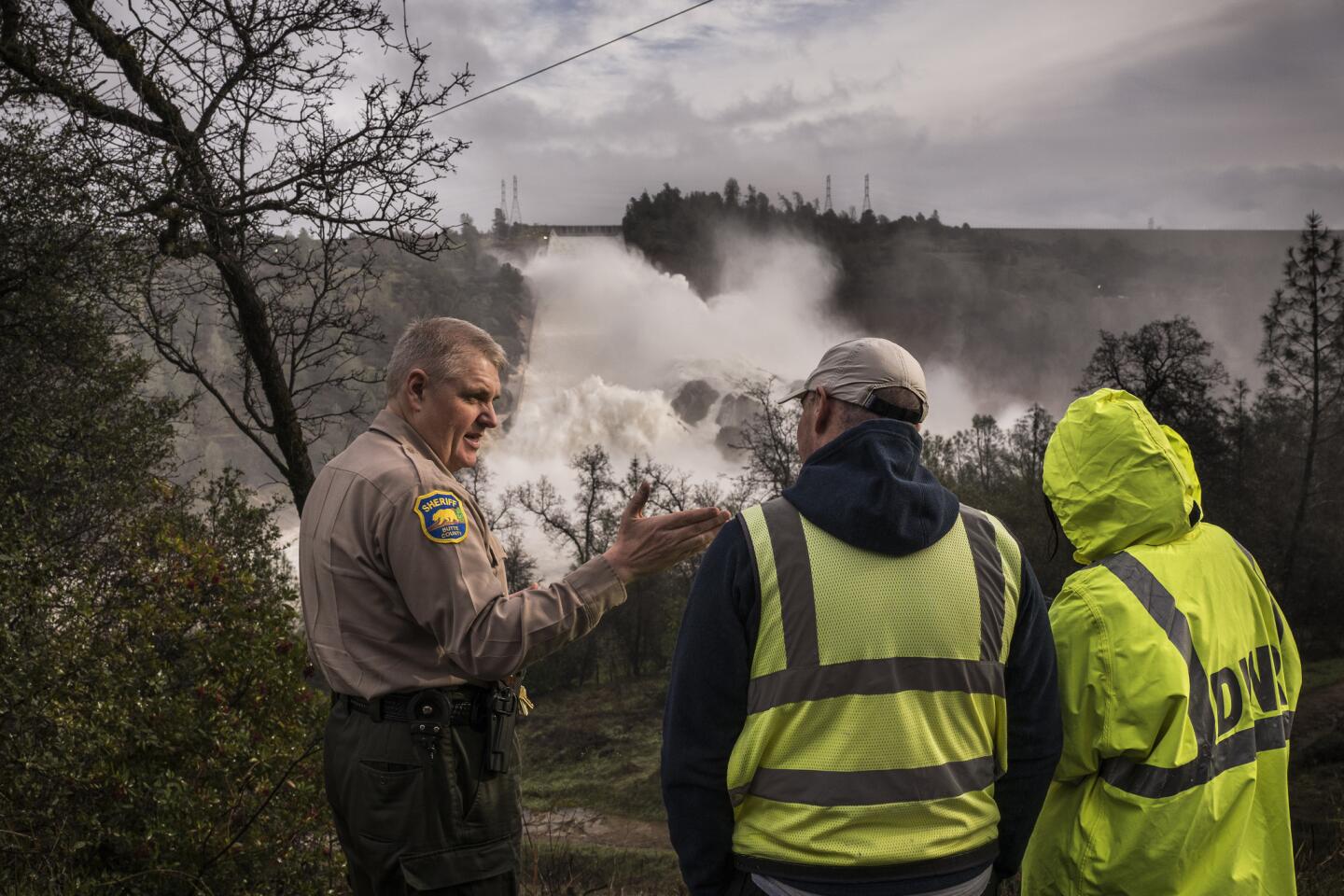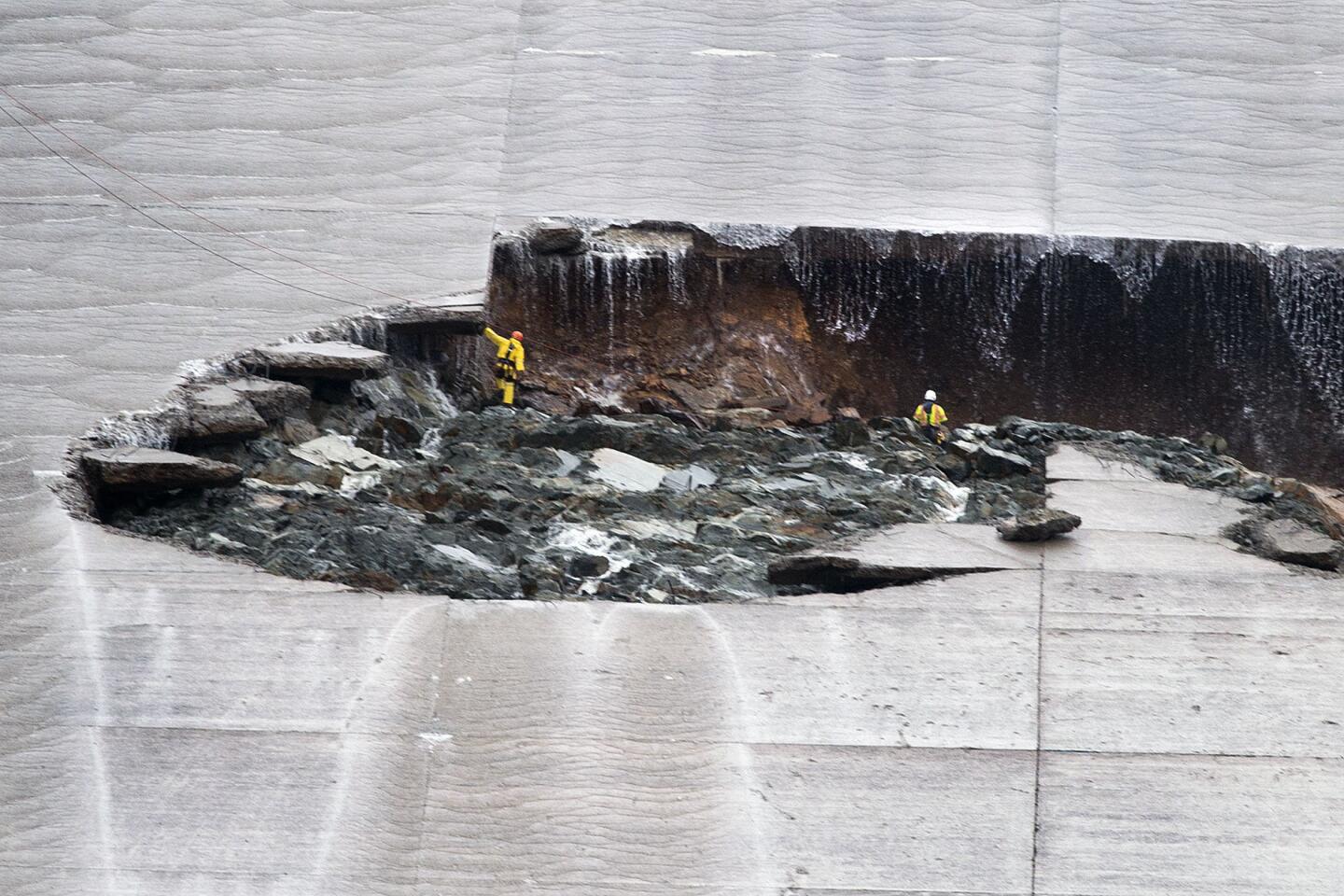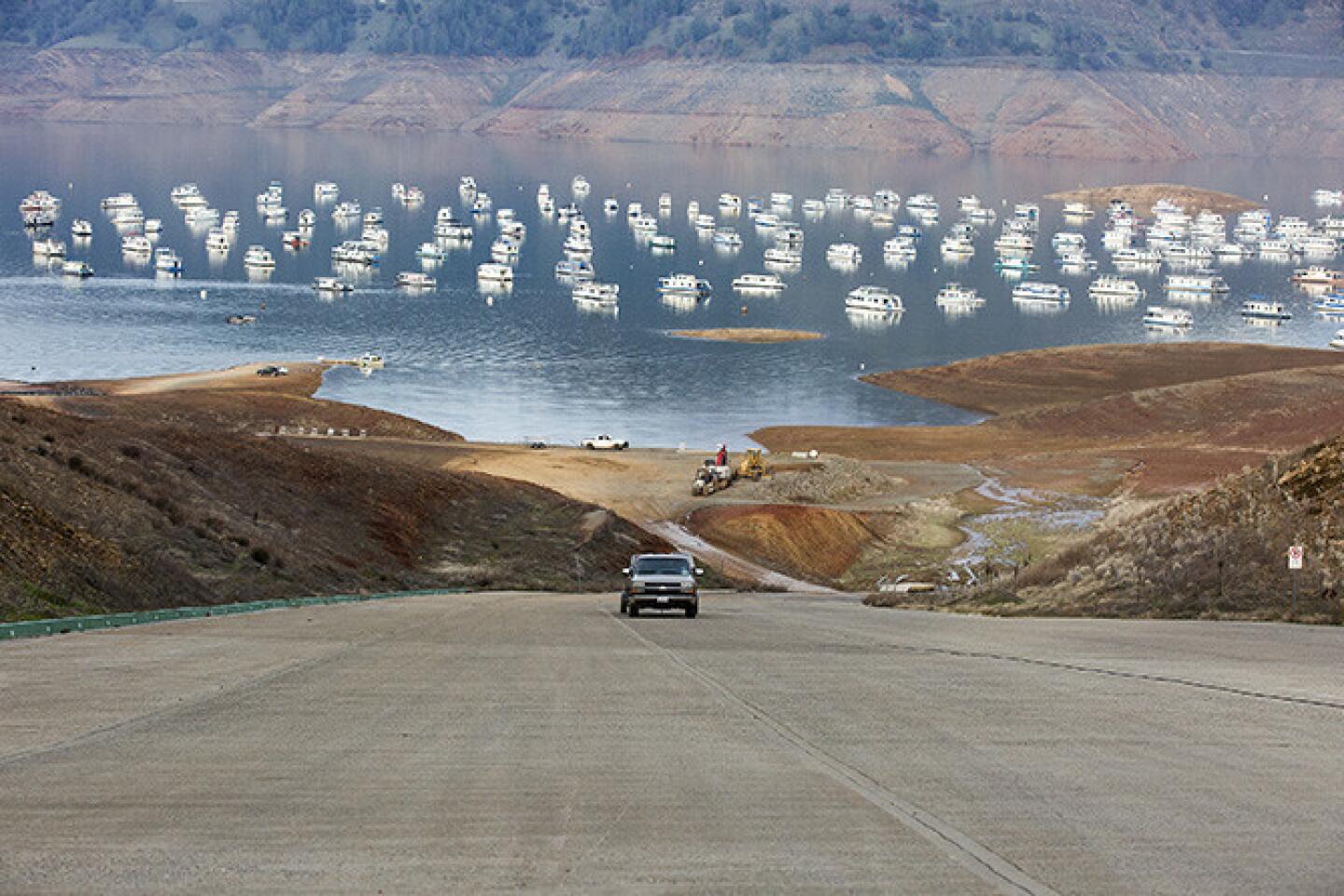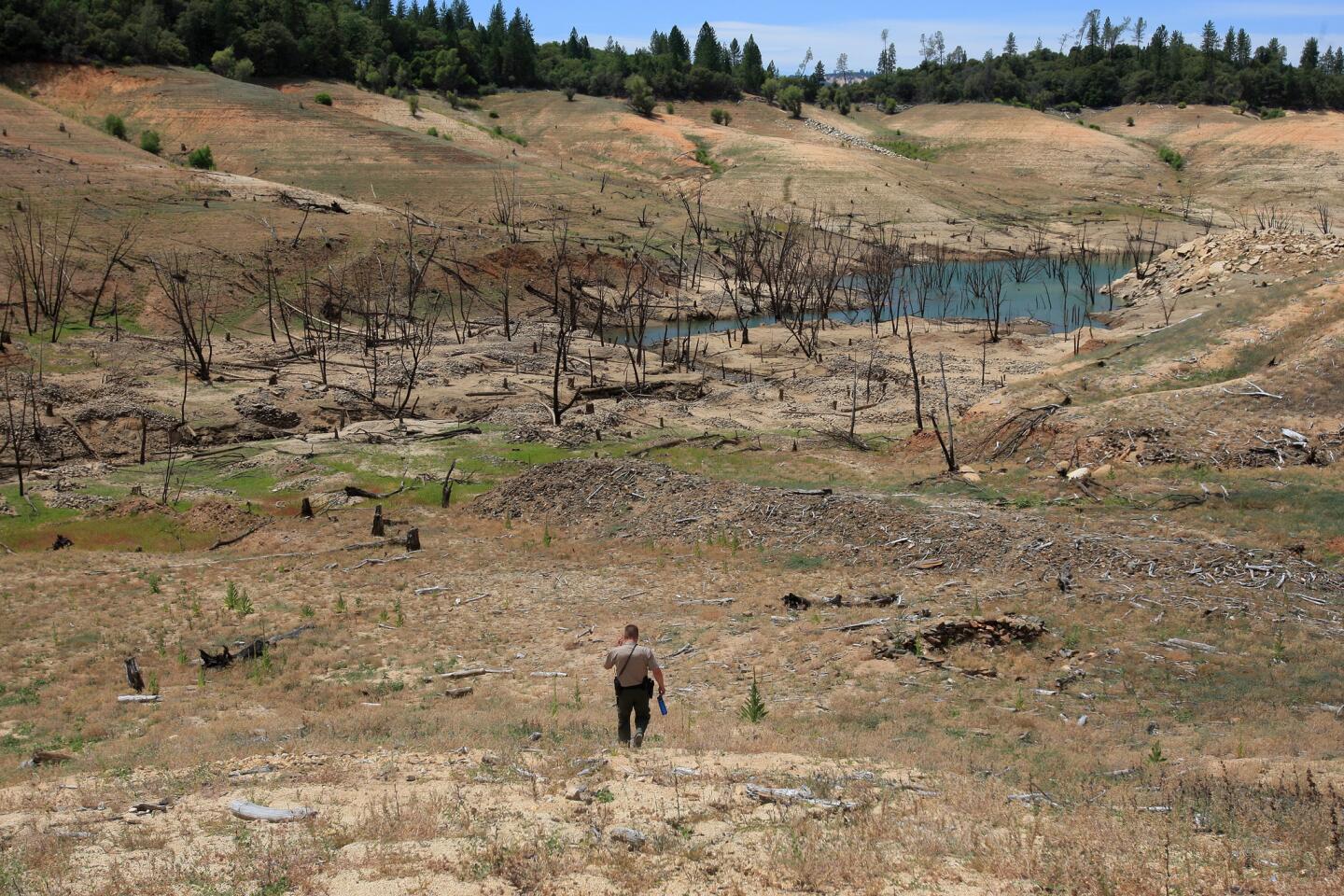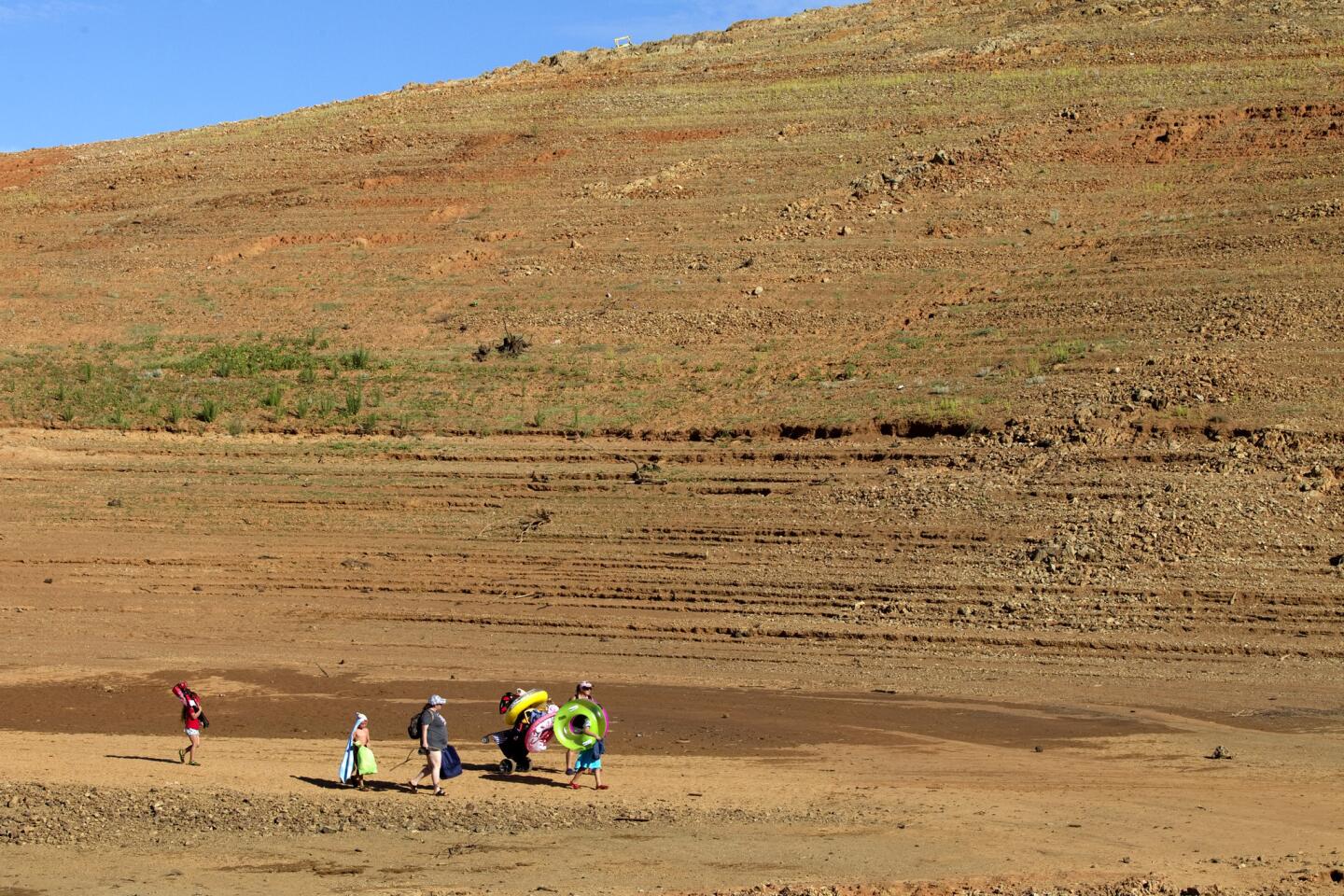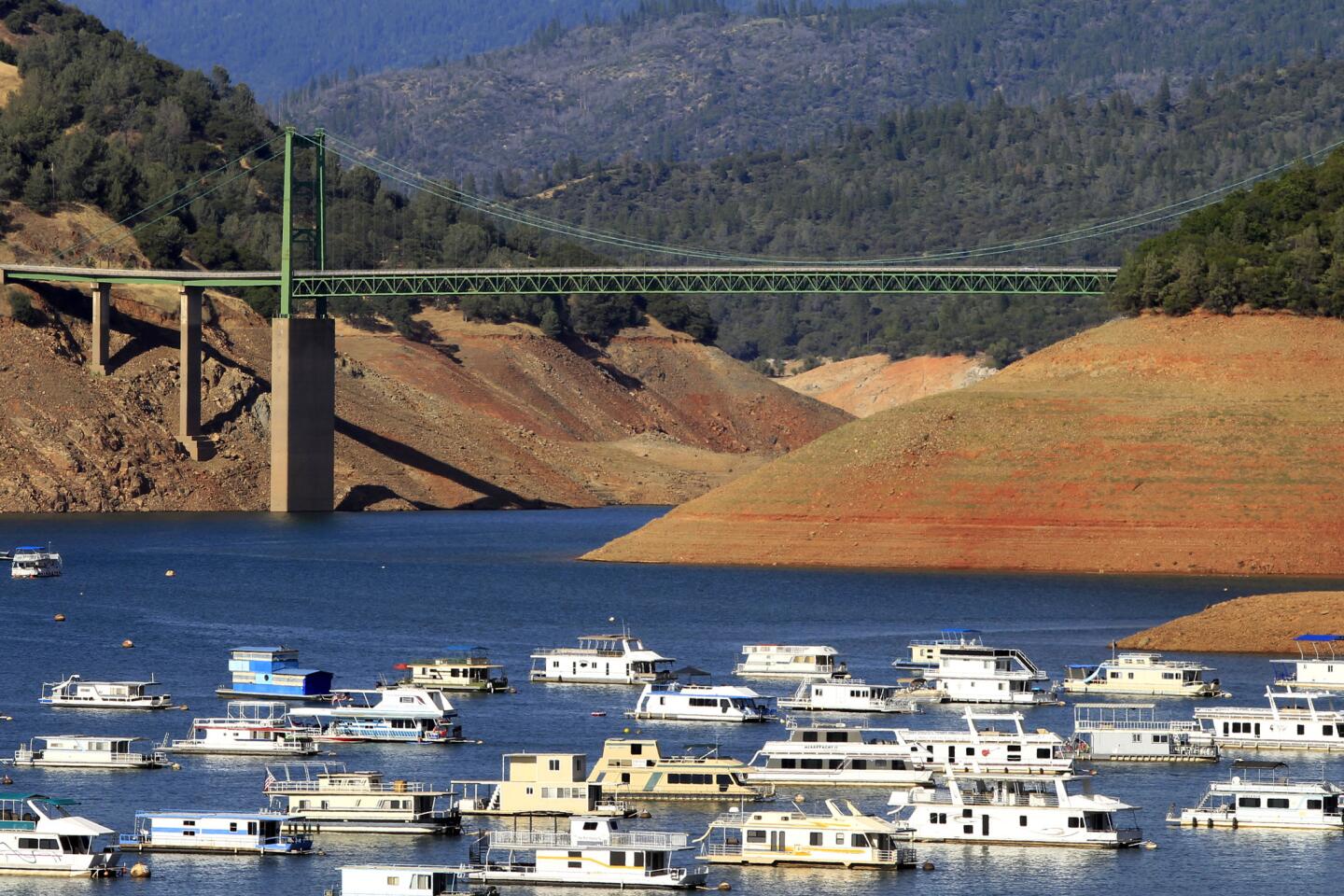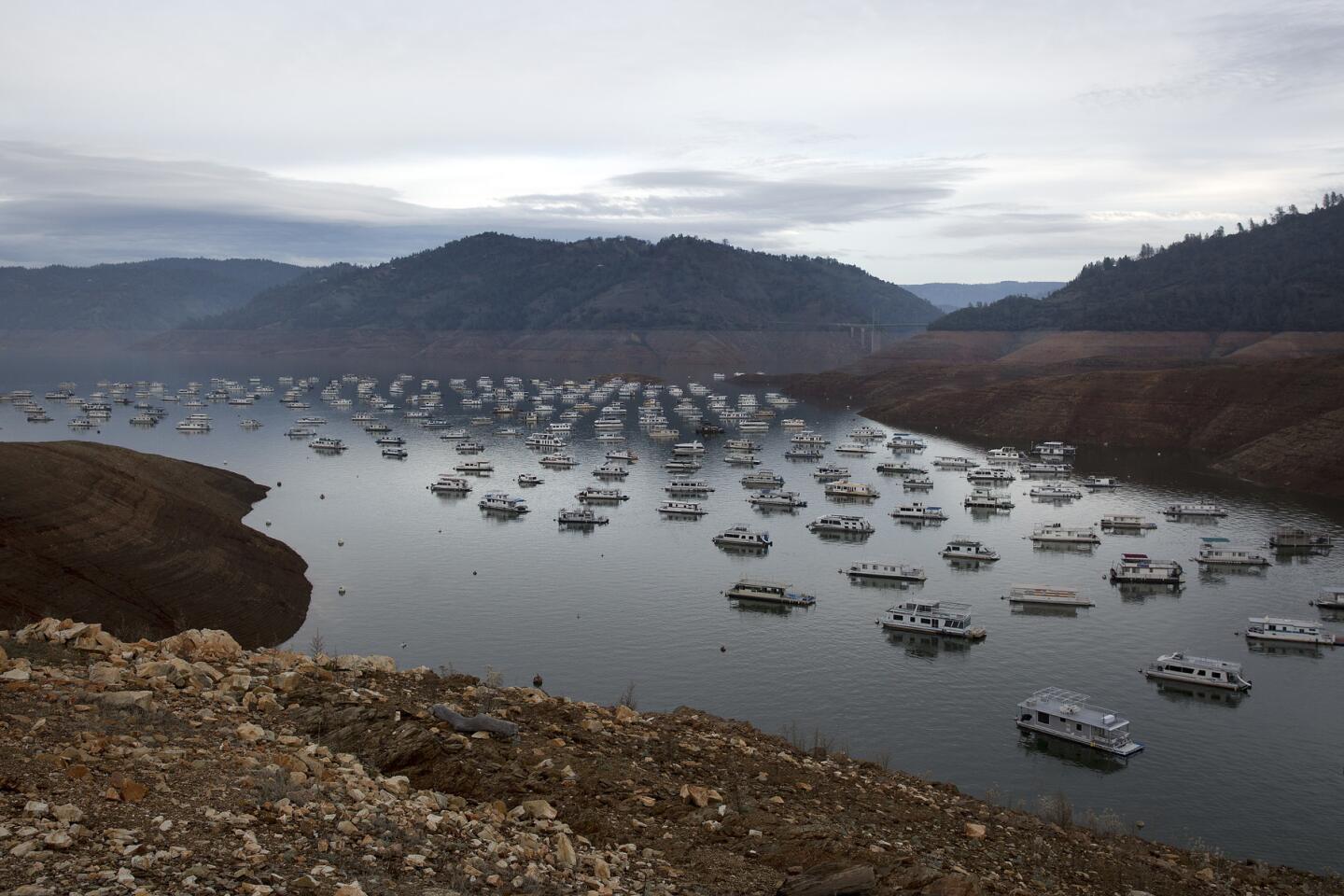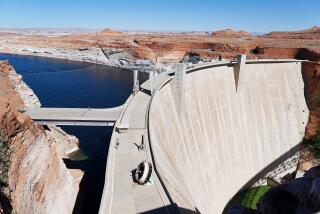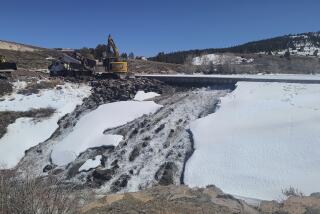Reporting from Oroville, Calif. — With more storms expected to slam Northern California later this week, officials worked frantically Monday to drain water from brimming Lake Oroville in hopes of heading off a potentially catastrophic flood.
The operators at America’s tallest dam found themselves in a precarious position Monday, with both of the spillways used to release water compromised and the reservoir still filled almost to capacity after a winter of record rain and snow. Meanwhile, tens of thousands of evacuated residents downstream of the dam still have no clear word when they can return home.
Officials sent millions of gallons of water per minute down the massive reservoir’s main spillway. Engineers said that despite a huge gash that opened in the concrete channel a week ago, it was their best option for lowering the dangerously high lake level.
They hoped this would avert further use of the emergency spillway, where damage was discovered Sunday afternoon.
“It was the lesser of two evils,” state Department of Water Resources spokesman Eric See said Monday. “We didn’t want to have more damage, but we needed to evacuate water.”
The emergency spillway suffered severe erosion the day after water cascaded down the unpaved hillside for the first time since the dam opened in 1968.
The damage occurred even though the spillway was designed to handle much more water than the amount that overflowed. Some questioned why officials didn’t heed suggestions more than a decade ago to fortify the emergency spillway.
When it appeared the erosion could quickly worsen Sunday afternoon and potentially undermine the spillway’s concrete lip — a scenario that could unleash a massive wall of water — officials ordered more than 100,000 people to evacuate the low-lying areas along the Feather River.
Racing against Mother Nature, water resources officials Monday sent water surging down the concrete main spillway -- a move that lowered the lake level by several feet but threatened to widen the gash. Erosion on the main spillway so far was manageable, See said.
“I’ve been doing these flood battles since 1978,” said state Sen. Jim Nielsen (R-Gerber). “This is the one with the greatest potential for damage of all the ones I’ve dealt with.”
Both spillways are separate from the Oroville Dam itself, which officials say is not in danger of collapsing.
Officials said they want to lower the lake 50 feet by Wednesday to avoid another overflow on the damaged emergency spillway. If the head of the spillway crumbles, a 30-foot wall of water could go crashing down the hillside into the Feather River and toward Oroville, Marysville and Yuba City.
“Obviously any rain this week is not helpful at all,” said Tom Dang, a National Weather Service meteorologist in Sacramento.
On Monday, geysers of water shot from the placid lake and down the concrete spillway, like a water slide the width of a freeway.
Live updates from Lake Oroville »
1/66
An aerial view of the water flowing out of the Oroville Dam main spillway, in Oroville, Calif., on Tuesday, February 21, 2017.
(Marcus Yam / Los Angeles Times) 2/66
An aerial view of the water flowing out of the Oroville Dam’s main spillway on Feb. 21. (Marcus Yam / Los Angeles Times)
3/66
Reduced water releases at the Oroville Dam have made damage to its main spillway more visible. (Marcus Yam / Los Angeles Times)
4/66
With a reduced flow on Sunday, most of the water being released from the Oroville Dam is not going down the spillway; it has broken through and is flowing down the hillside. (Marcus Yam / Los Angeles Times)
5/66
With a reduced flow on Sunday, most of the water being released from the Oroville Dam is not going down the spillway, it’s broken through and is going down the hillside.
(Marcus Yam / Los Angeles Times) 6/66
With a reduced flow on Sunday, most of the water being released from the Oroville Dam is not going down the spillway, it’s broken through and is going down the hillside.
(Marcus Yam / Los Angeles Times) 7/66
Juan Alvarez reassures his girlfriend, Sarah Hendrix, after helping her move out of her home in rural Maxwell. Water was a foot high and crews had to evacuate 100 people because of flooding-- some by boat.
(Marcus Yam / Los Angeles Times) 8/66
Ron Chambers lets Duke out of his crate for the first time in hours since the flooding began n Maxwell, Calif. on Saturday.
(Marcus Yam / Los Angeles Times) 9/66
Kevin Anfinson and other volunteers help shovel the muddy sediment that has built up in the salmon raceway at the Feather River Fish Hatchery in Oroville, Calif. (Marcus Yam / Los Angeles Times)
10/66
Fernando Martinez and his mother, not pictured, wade through a road in Gridley, Calif., flooded by the Feather River as it continues to swell from the water being let out of Lake Oroville.
(Marcus Yam / Los Angeles Times) 11/66
A man in a 4x4 truck turns around on Gridley Road after having second thoughts about making it across the flooded road, which had been closed.
(Brian van der Brug / Los Angeles Times) 12/66
Randy Boheim packs up his tools and emergency supplies in anticipation of having to evacuate his whole family as floodwaters creep closer to his home in an Oroville, Calif., mobile home park. The nearby Feather River continued to swell from the water being let out of Lake Oroville ahead of this weekend’s storm.
(Marcus Yam / Los Angeles Times) 13/66
A plantation in Oroville, Calif., sits in floodwaters as the Feather River continues to swell from the water being let out of Lake Oroville ahead of this weekend’s storm.
(Marcus Yam / Los Angeles Times) 14/66
Helicopters ferry sand and rocks to the Oroville Dam’s emergency spillway reconstruction project in Oroville, Calif., ahead of coming rains.
(Brian van der Brug / Los Angeles Times) 15/66
California Water Service district manager Toni Ruggle surveys the Feather River at Bedrock Park downstream from the Oroville Dam.
(Brian van der Brug / Los Angeles Times) 16/66
McKenna Harvey, 9, left, Kylie Atteberry, 11, and Brooklyn Atteberry, 7, hold signs thanking workers in the repair effort at the Oroville Dam.
(Brian van der Brug / Los Angeles Times) 17/66
A helicopter flies over as water flows from the main spillway at Lake Oroville. (Marcus Yam / Los Angeles Times)
18/66
Reconstruction continues in a race to shore up the emergency spillway at Oroville Dam. (Brian van der Brug / Los Angeles Times)
19/66
As rain clouds gather, friends from left, Johnny Eroh, Cody Balmer, Kristien Bravo and Jerel Bruhn hang out by the flooded Feather river in the Bedrock neighborhood of Oroville, Calif., last week. (Marcus Yam / Los Angeles Times)
20/66
Evacuees at the Bangor Community Hall in Bangor, Calif., listen to Butte County sheriff’s deputies in February as the mandatory evacuation order was lifted. An evacuation advisory was lifted Wednesday. (Brian van der Brug / Los Angeles Times)
21/66
Evacuees at the Bangor Community Hall get the news from Butte County sheriff’s Deputy Jeff Heath that the evacuation order has been lifted.
(Brian van der Brug / Los Angeles Times) 22/66
Evacuee Sharon Dalton, right, hugs Raiden Ellis, 10 months, and Chris Ellis as they say their goodbyes as she leaves the Bangor Community Hall in Bangor, Calif., on Tuesday.
(Brian van der Brug / Los Angeles Times) 23/66
David McGlamery returns to his Oroville home with his belongings after the evacuation order was lifted. The family had to retreat to Chico, where they initially stayed at a Walmart parking lot with other evacuees. (Marcus Yam / Los Angeles Times)
24/66
Bill Tirey helps family members move back into their home in the Bedrock neighborhood of Oroville near the Feather River after evacuation orders were lifted.
(Marcus Yam / Los Angeles Times) 25/66
Maria Alancar returns home to greets her pet pig Bacon, who was left behind when the family moved to higher ground in Honcut, Calif.
(Brian van der Brug / Los Angeles Times) 26/66
Sulet Lopez, 21, left, Melissa Mendoza, 3, and Yeanet Lopez, 18, pack up their car at the Bangor Community Hall in Bangor, Calif., to head home after the evacuation order was lifted.
(Brian van der Brug / Los Angeles Times) 27/66
Erica Stenholm, left, Ronnie Vaughan, and Brooklyn Jackson, 7, unpack their car upon returning home after the evacuation order had been lifted in Oroville.
(Marcus Yam / Los Angeles Times) 28/66
Jonah Avina, left, and his wife, Eileen, pray before lunch at the Maranatha Mennonite Fellowship in Bangor, Calif., on Tuesday. The Bangor-area Mennonites are hosting several immigrant families evacuated from the nearby town of Honcut.
(Brian van der Brug / Los Angeles Times) 29/66
Evacuee Estafani Reynoso, left, colors with Mennonite children at the Maranatha Mennonite Fellowship in Bangor, Calif.
(Brian van der Brug / Los Angeles Times) 30/66
Crews work on a damaged section of the emergency spillway at Lake Oroville on Monday. (Josh Edelson / AFP/ Getty Images)
31/66
An Oroville property is flooded on Monday as thousands were under evactuation orders.
(Josh Edelson / AFP/Getty Images) 32/66
The Marysville cemetery underwater along the Feather River.
(Marcus Yam / Los Angeles Times) 33/66
Nirmal Singh, a Sikh priest, conducts a morning prayer ritual as evacuees sleep in the background at the Shri Guru Ravidass, a Sikh temple that has opened its doors for evacuees of the Oroville Dam crisis in Rio Linda, Calif.
(Marcus Yam / Los Angeles Times) 34/66
Kamlesh Nahar, far left, talks to fellow evacuees at the Shri Guru Ravidass Temple.
(Marcus Yam / Los Angeles Times) 35/66
Maria Lopez reads on her smartphone as she spends a second night in her father’s car in the parking lot of the Bangor Community Hall.
(Brian van der Brug / Los Angeles Times) 36/66
Sharon Dalton finds a quiet spot under a table as she spends a second night with her dog Cruiser inside the Bangor Community Hall.
(Brian van der Brug / Los Angeles Times) 37/66
Verna Chadwick and 10-month-old son Raiden Ellis during a second night in the Bangor Community Hall.
(Brian van der Brug / Los Angeles Times) 38/66
The emergency spillway, left, and the damaged main spillway at Lake Oroville are seen in an aerial photo Monday.
(Elijah Nouvelage / Getty Images) 39/66
A dump truck crosses the primary spillway to deliver boulders to the damaged emergency spillway at Lake Oroville on Monday evening.
(Brian van der Brug / Los Angeles Times) 40/66
Helicopters place large rocks on the damaged emergency spillway at Lake Oroville on Monday evening.
(Brian van der Brug / Los Angeles Times) 41/66
Around-the-clock monitoring continues on the damaged primary spillway at Lake Oroville on Monday evening.
(Brian van der Brug / Los Angeles Times) 42/66
Water rushes down a spillway at the Oroville Dam. (Brian van der Brug / Los Angeles Times)
43/66
California Department of Fish and Game wardens view the damaged spillway on Monday. (Brian van der Brug / Los Angeles Times)
44/66
Bill O’Kelley, 86, and wife Doris O’Kelley, 84, of Oroville sit near a flagpole Monday at the Silver Dollar Fairgrounds evacuation center in Chico, Calif.
(Brian van der Brug / Los Angeles Times) 45/66
Coua Tha, of Oroville prepares a meal for her family in the parking lot at the Silver Dollar Fairgrounds evacuation center in Chico, Calif.
(Brian van der Brug / Los Angeles Times) 46/66
Desiree Garcia and daughter Kay’lee Pearl Garcia, 3, of Oroville look over donated clothing Monday at the Silver Dollar Fairgrounds evacuation center in Chico, Calif.
(Brian van der Brug / Los Angeles Times) 47/66
Members of Oroville’s Jordan Crossing Mission pray with a volunteer service member Monday at the Silver Dollar Fairgrounds evacuation shelter in Chico, Calif.
(Brian van der Brug / Los Angeles Times) 48/66
The swollen Feather River flows through Oroville, Calif., on Monday.
(Rich Pedroncelli / Associated Press) 49/66
A building is submerged in Riverbend Park as more water is released from Lake Oroville.
(JOSH EDELSON / AFP) 50/66
Siblings Zach Soto, 11, left, and Gabby Soto, 13, keep an eye on the Feather River along a railroad bridge in Oroville, Calif., on Monday. The family decided to stay in Oroville as they live on high ground near downtown.
(Brian van der Brug / Los Angeles Times) 51/66
Water flows down the damaged main spillway of the Oroville Dam at 55,000 cubic feet per second into the Feather River. (Brian van der Brug / Los Angeles Times)
52/66
Water from Lake Oroville flows down the damaged main spillway.
(Brian van der Brug / Los Angeles Times) 53/66
Water from Lake Oroville flows down the emergency spillway of the Oroville Dam toward the Feather River.
(Brian van der Brug / Los Angeles Times) 54/66
Pacific Gas & Electric crews aided by a helicopter removed transmission lines and insulators from towers standing in the bed of the emergency spillway of Lake Oroville.
(Brian van der Brug / Los Angeles Times) 55/66
A rainbow appears over Feather River as water cascades down the damaged spillway at Lake Oroville Dam.
(Brian van der Brug / Los Angeles Times) 56/66
Water cascades down the spillway below Oroville Dam. The water is being released by authorities to avoid flooding at Lake Oroville because of recent heavy rain. (David Butow / For The Times)
57/66
Pacific Gas and Electric Co. crews move two electric transmission line towers on the bank of Feather River as a precaution if the Lake Oroville Dam emergency spillway needs to be used.
(Brian van der Brug / Los Angeles Times) 58/66
A California Highway Patrol cruiser patrols Lake Oroville Dam, which is closed to the public due to the damaged spillway.
(Brian van der Brug / Los Angeles Times) 59/66
Water cascades down the spillway below the Oroville dam. The water is being released by authorities to ease flooding in Lake Oroville because of recent heavy rain.
(David Butow / For the Times) 60/66
Butte Country Sheriff Kory L. Honea speaks with department of water and power workers at an overlook as the observe runoff from the Oroville Dam.
(David Butow / For the Times) 61/66
Water trickles down as workers inspect part of the Lake Oroville spillway failure in Oroville, Calif.
(Randy Pench / Associated Press) 62/66
A boat launch at Bidwell Canyon is still hundreds of yards above the current lake level on Jan. 21, 2016.
(Brian van der Brug / Los Angeles Times) 63/66
California State Park Ranger Bryan Taylor searches for signs of disturbance or theft as California’s severe drought conditions are revealing historic artifacts at Lake Oroville, June 21, 2014.
(Allen J. Schaben / Los Angeles Times) 64/66
Severe drought conditions are evident as a family treks across a long path back to their car at Lake Oroville, June 21, 2014.
(Allen J. Schaben / Los Angeles Times) 65/66
Houseboats are dwarfed by steep banks that show the water level down 160 feet from the high water mark at the Bidwell Bar Suspension Bridge over Lake Oroville on June 21, 2014.
(Allen J. Schaben / Los Angeles Times) 66/66
Houseboats at Bidwell Canyon Marina at Lake Oroville, January 21, 2016.
(Brian van der Brug / Los Angeles Times) Helicopters flew overhead and dump trucks shuttled across the top of Oroville Dam, carrying loads of rock to fill the eroded section. Without reinforcements, water could creep beneath the lip, causing it to crumble and allowing water to gush over the side.
In a letter Monday, Gov. Jerry Brown asked the Trump administration for a federal disaster declaration, saying the problems were likely to be more than local and state officials can handle.
Brown told reporters that he spoke to a member of the president’s Cabinet on Monday, but declined to say which one. “My office has been in touch with the White House,” Brown said. “I think that will be sufficient.”
The Federal Emergency Management Agency, meanwhile, sent an eight-person team to the area to help California officials prepare for potential flooding.
“We are trying to plan for the worst-case scenario,” said Ahsha Tribble, acting regional administrator for FEMA’s Region 9, which includes California. “It’s not a wait-and-see game.”
Lake Oroville is the keystone of the State Water Project, which sends Northern California water hundreds of miles south to the southern San Joaquin Valley and the Southland.
During much of the five-year drought, the lake level was far below normal, forcing officials to slash water deliveries. But an extraordinarily wet winter filled the lake so close to capacity that officials have been forced to release water to prevent flooding.
A series of powerful storms Tuesday sent runoff rushing into the reservoir, just as the hole appeared in the main spillway. Managers slowed the release of the water, and on Saturday, Oroville overflowed.
Earth and weak rock near the top of the spillway started to erode, when peak flows were 12,600 cubic feet per second, compared with the designed capacity of 450,000 cubic feet per second, according to the Department of Water Resources. The erosion happened so quickly that officials feared the concrete wall would be undermined and ordered sweeping evacuations in Butte, Yuba and Sutter counties that remained in effect Monday night.
Bill Croyle, the acting director of the Department of Water Resources, said Monday that he was “not sure anything went wrong. This was a new, never-happened-before event.”
But during 2005 relicensing proceedings for Oroville Dam, several environmental groups argued that substantial erosion would occur on the hillside in the event of a significant emergency spill. In a filing, they asked the Federal Energy Regulatory Commission to order the state to “to armor or otherwise reconstruct the ungated spillway.”
State Water Project contractors, including the Metropolitan Water District of Southern California, were involved in the relicensing. MWD General Manager Jeffrey Kightlinger said Monday his agency deferred to the state and federal agencies on the matter.
“They did look at that issue and they determined that [the existing emergency spillway] did meet the appropriate FERC guidelines,” Kightlinger said. “In the FERC guidelines, they talk about how you don’t put a lot of funding and concrete, etc. into emergency spillways because presumably they will rarely if ever be used.”
“We did not say it was a cost issue,” he added.
Brown, after meeting with advisors at the state’s emergency operations center near Sacramento, was asked by reporters about the concerns raised in 2005 about Oroville’s spillway system.
He said he welcomed calls for more scrutiny. “We’re in a very complex society where things can go wrong,” he said. “When they do, they ripple out and affect hundreds of thousands and in some cases millions of people.”
Times staff writers John Myers in Sacramento and Veronica Rocha, Joseph Serna and Rong-Gong Lin II in Los Angeles contributed to this report.
[email protected] | Twitter: @chrismegerian
[email protected] | Twitter: @boxall
[email protected] | Twitter: @melmason
[email protected] | Twitter: @laura_nelson
ALSO
Engineers race to lower water level of Oroville reservoir before new storms move in
The frantic fight to keep the Oroville Dam crisis from turning into a catastrophe
Diagram explains the problem with Oroville Dam’s emergency spillway
